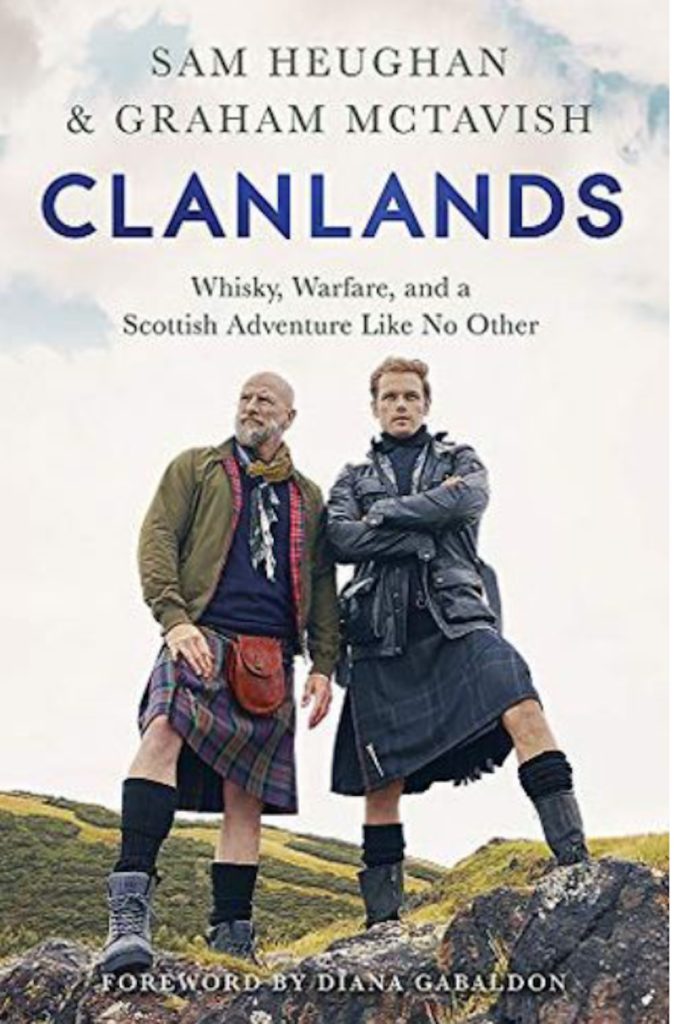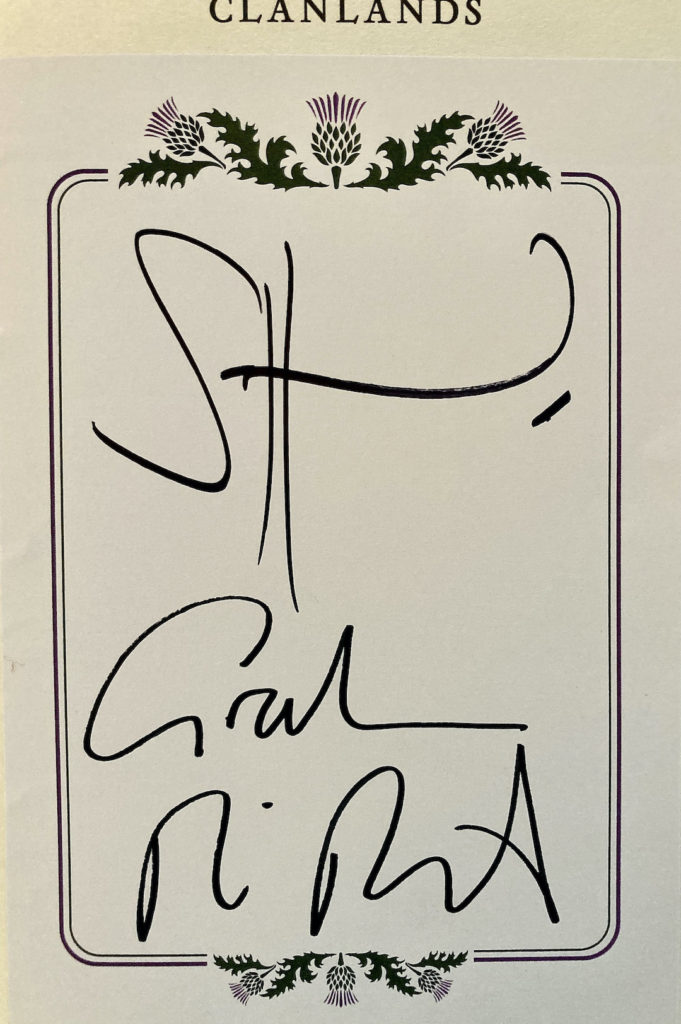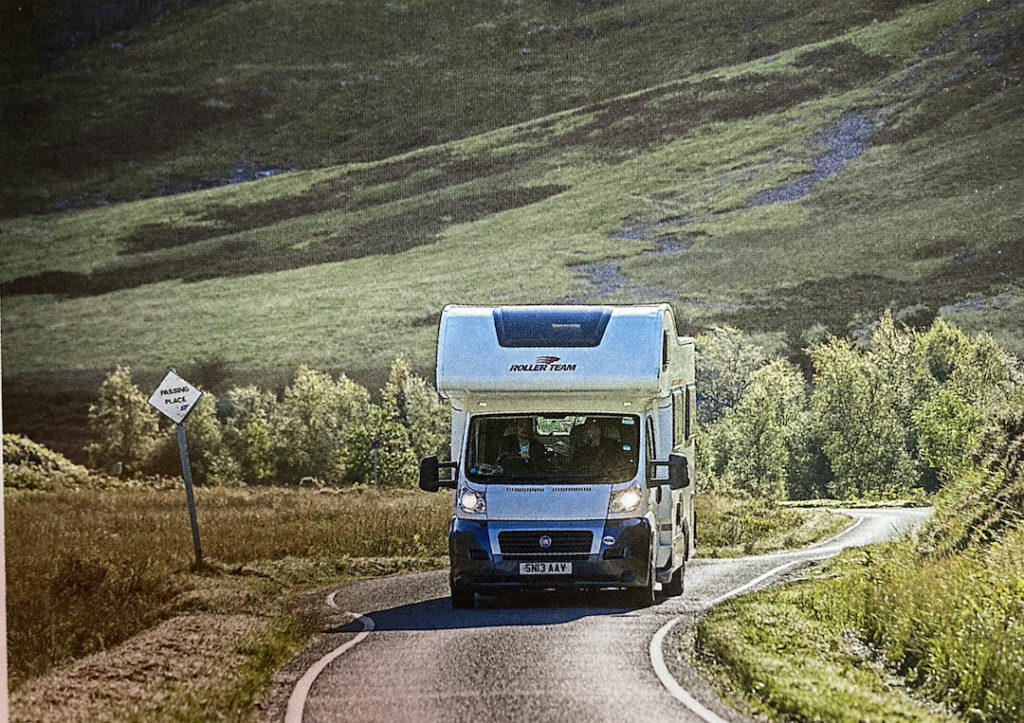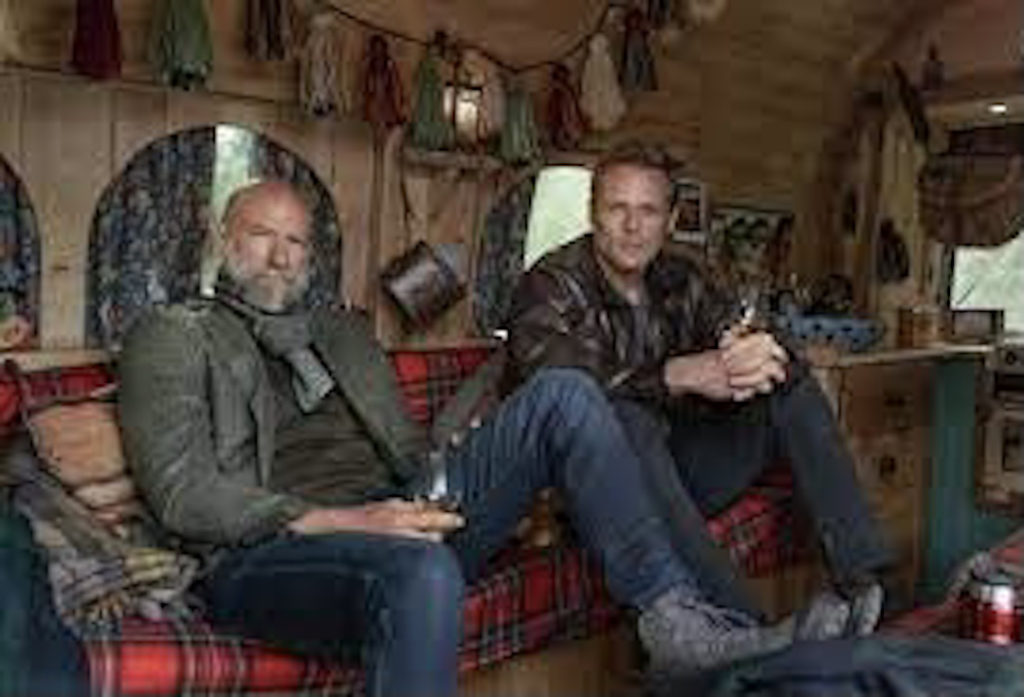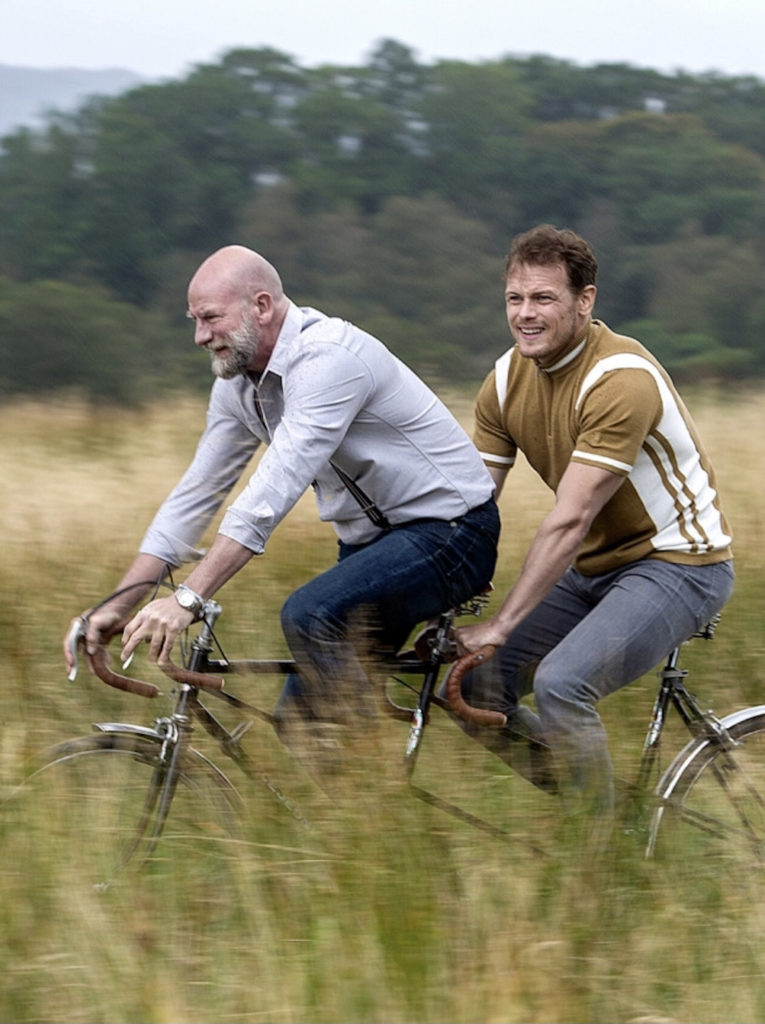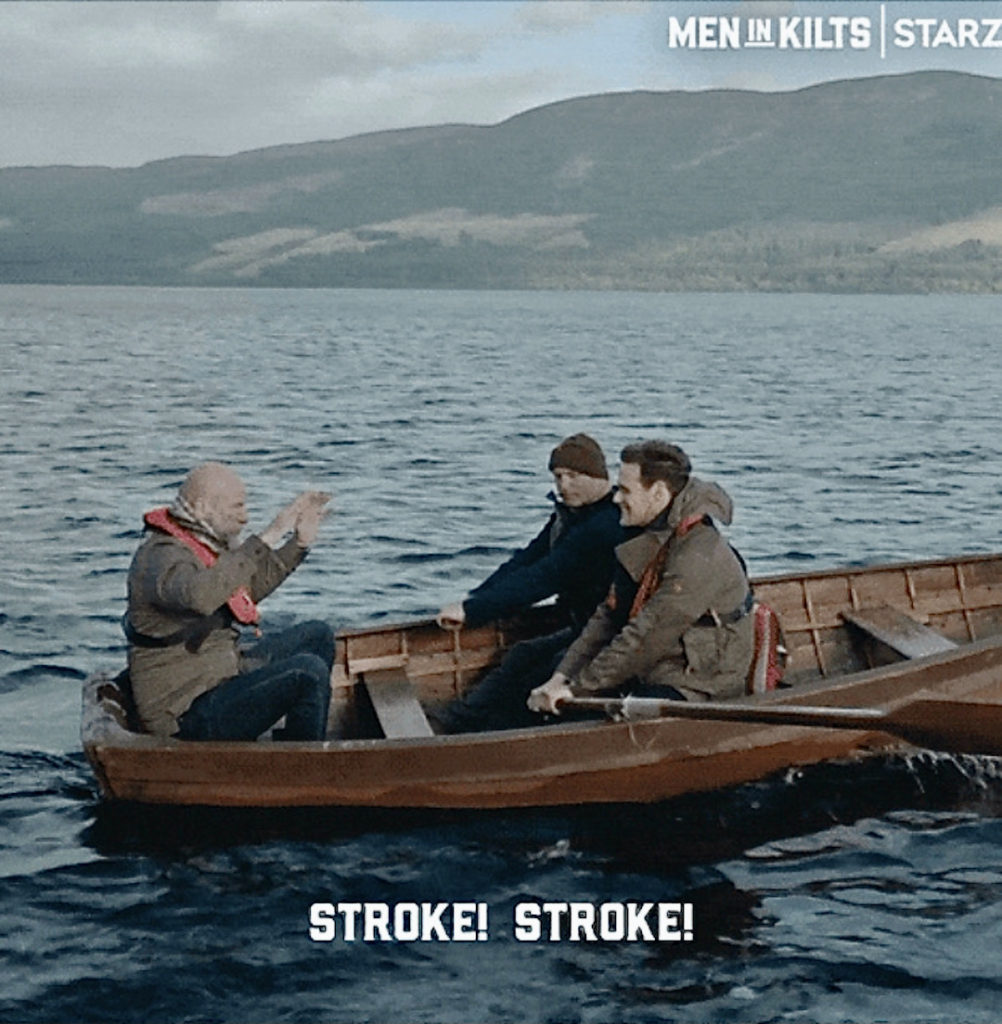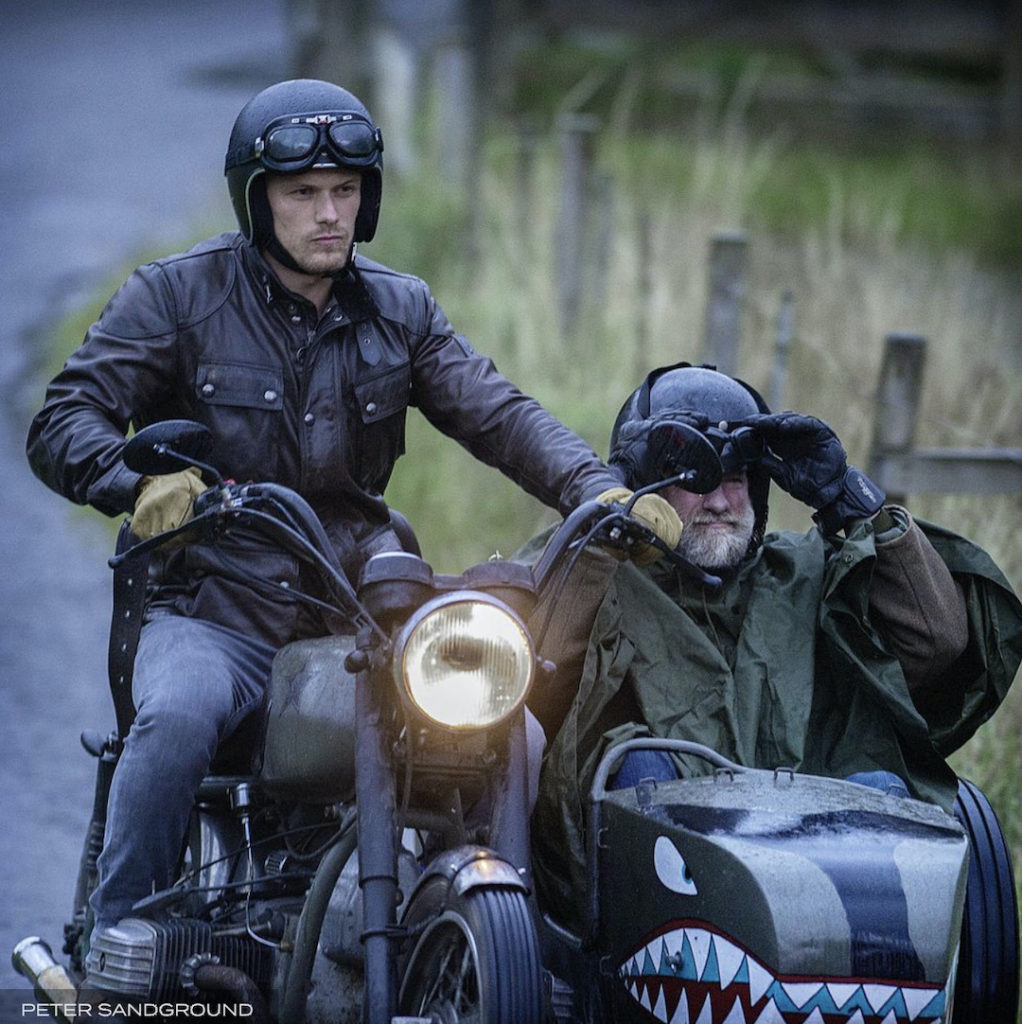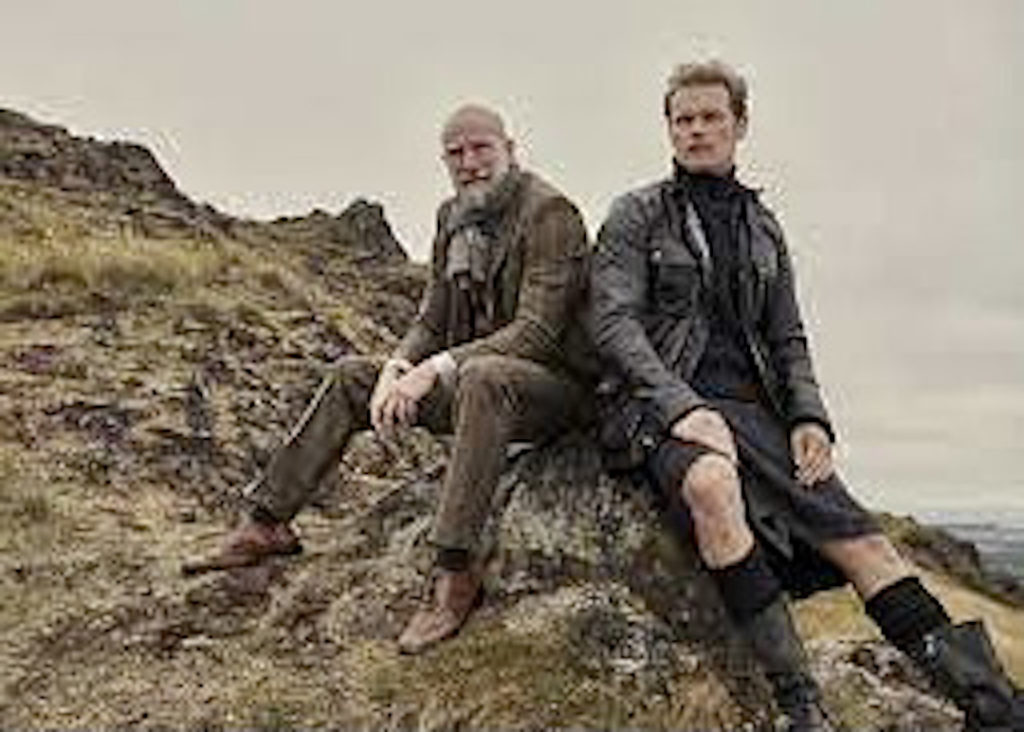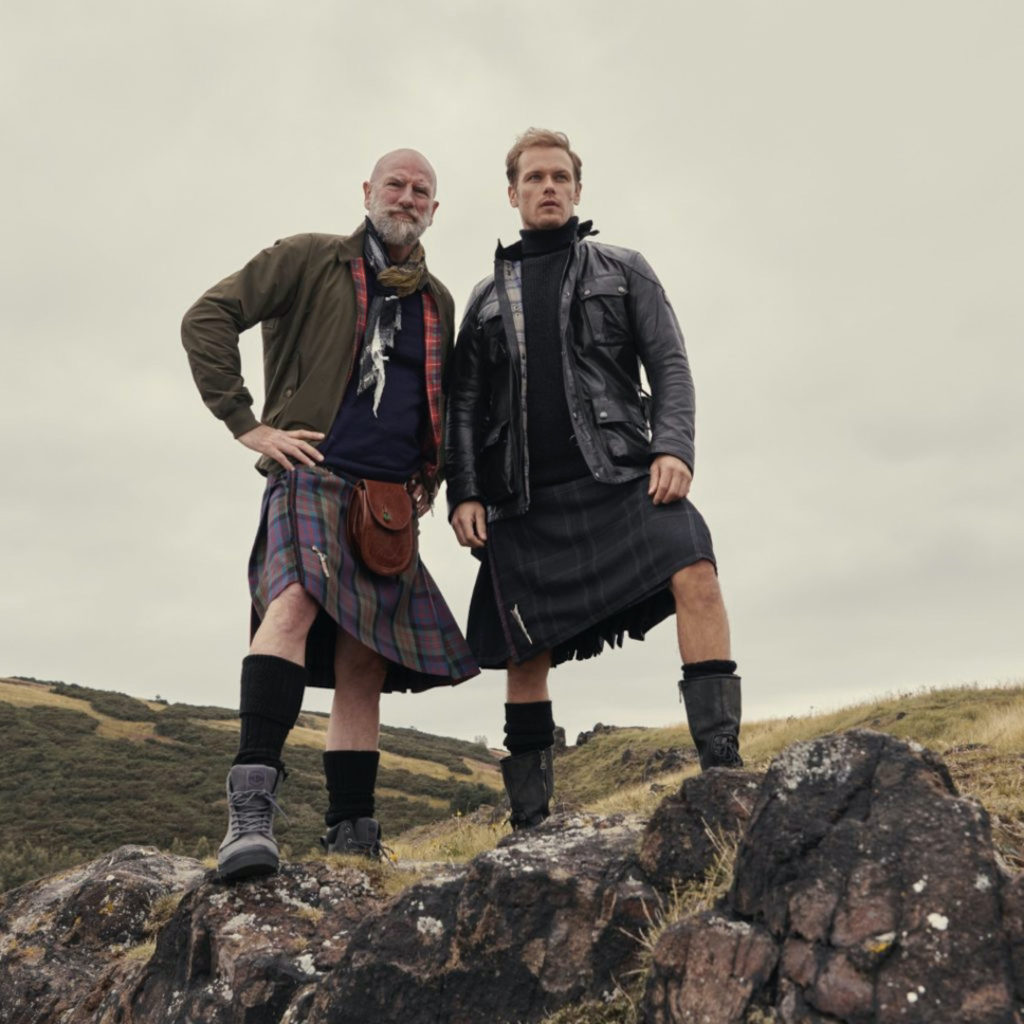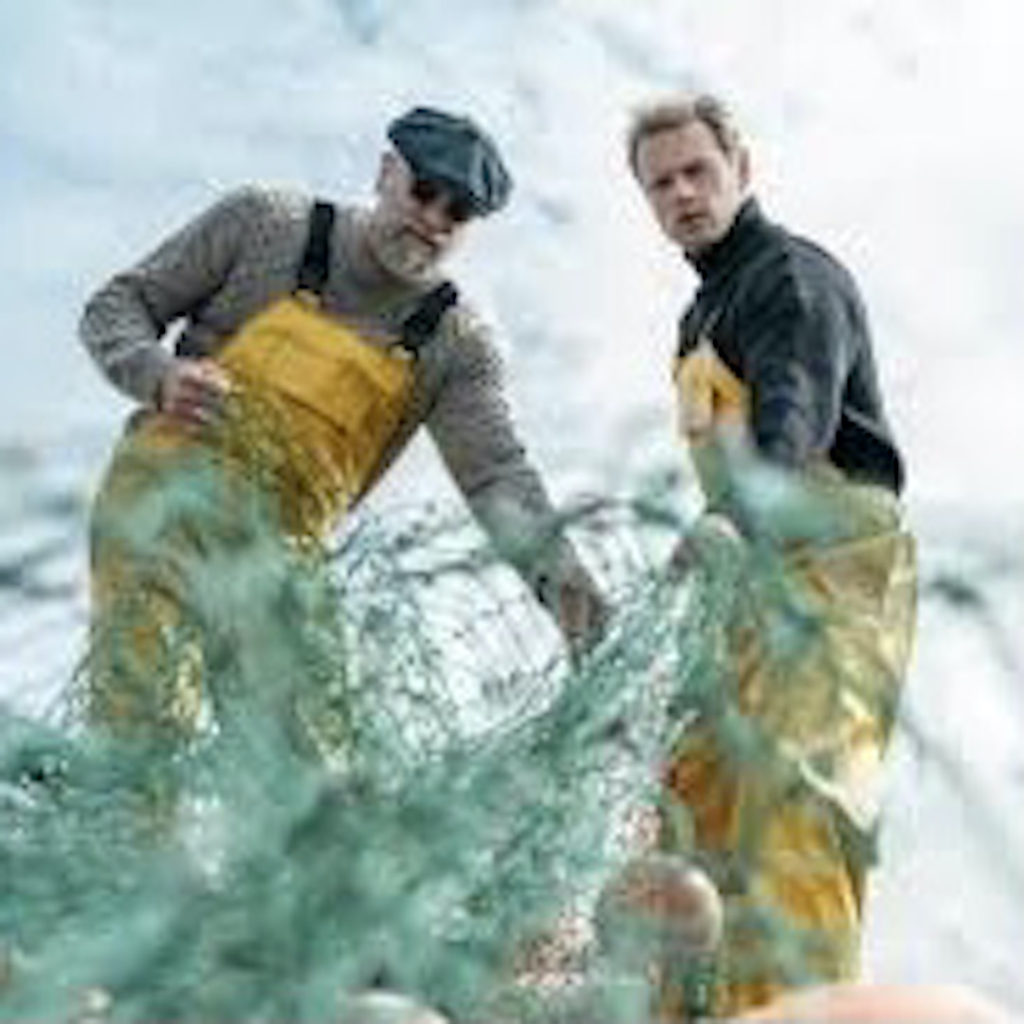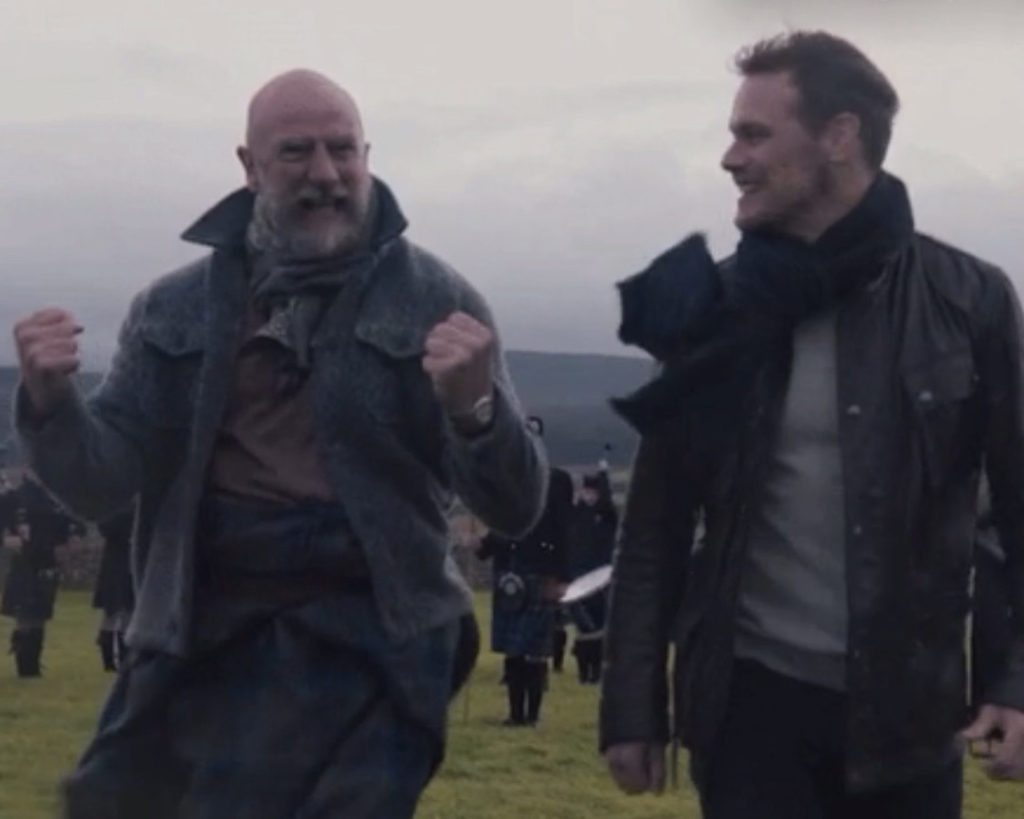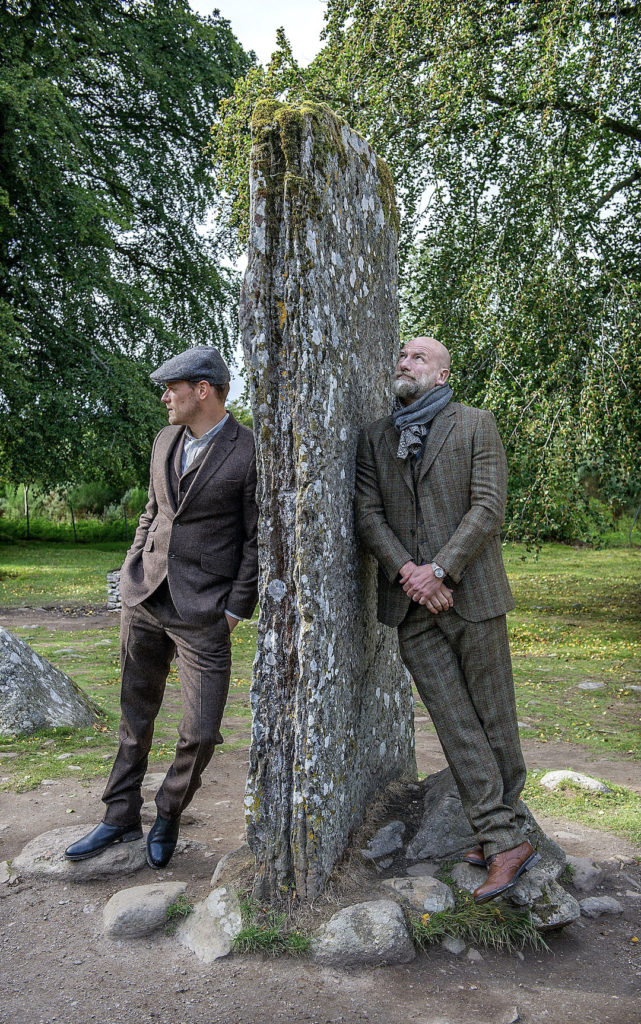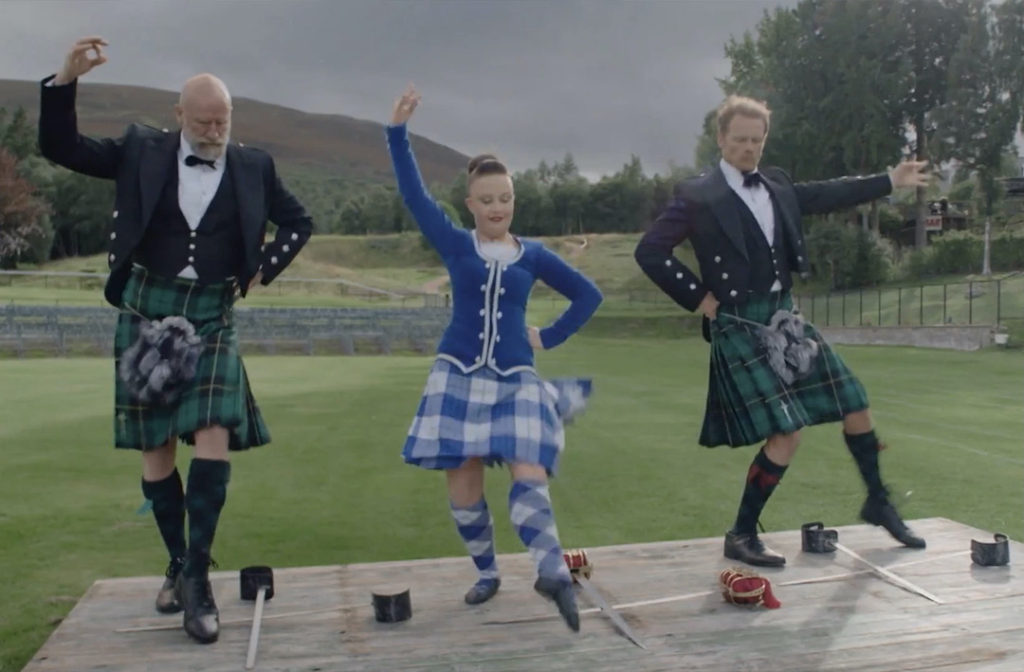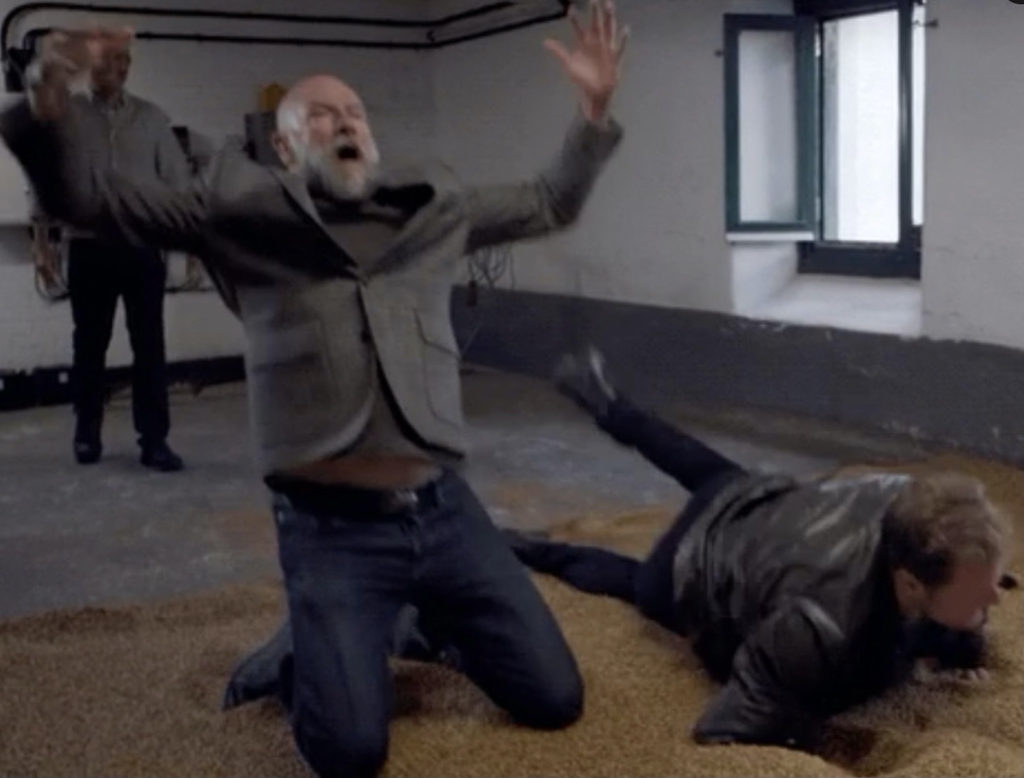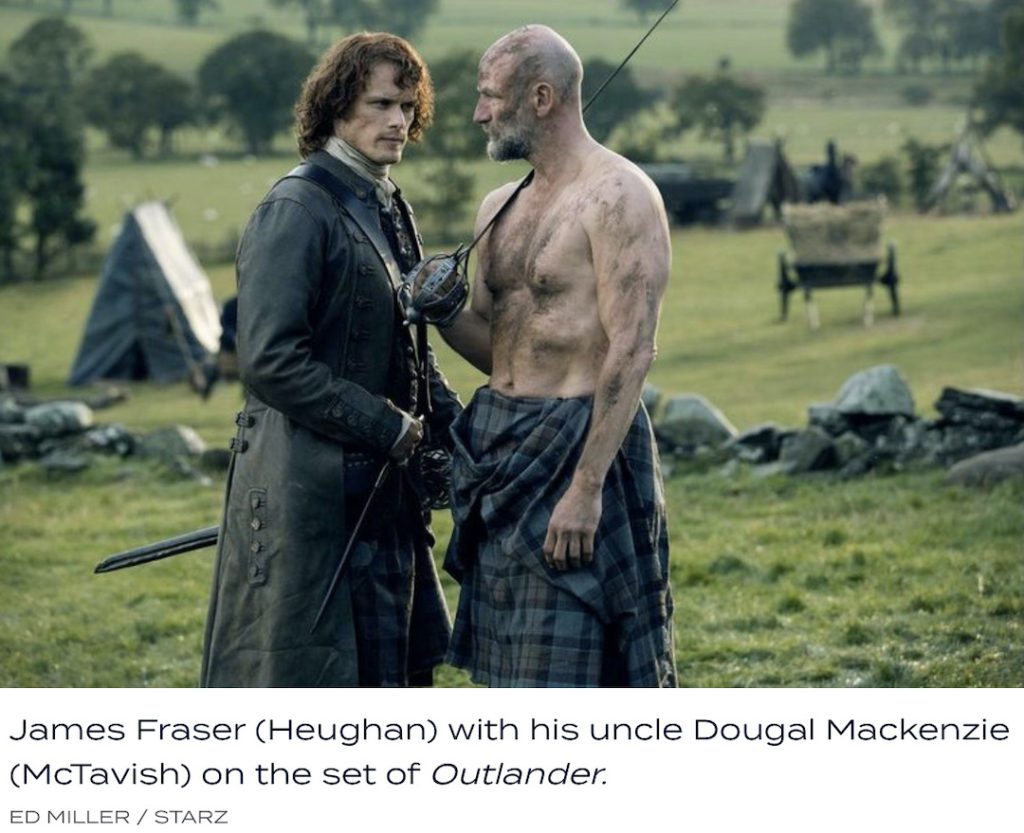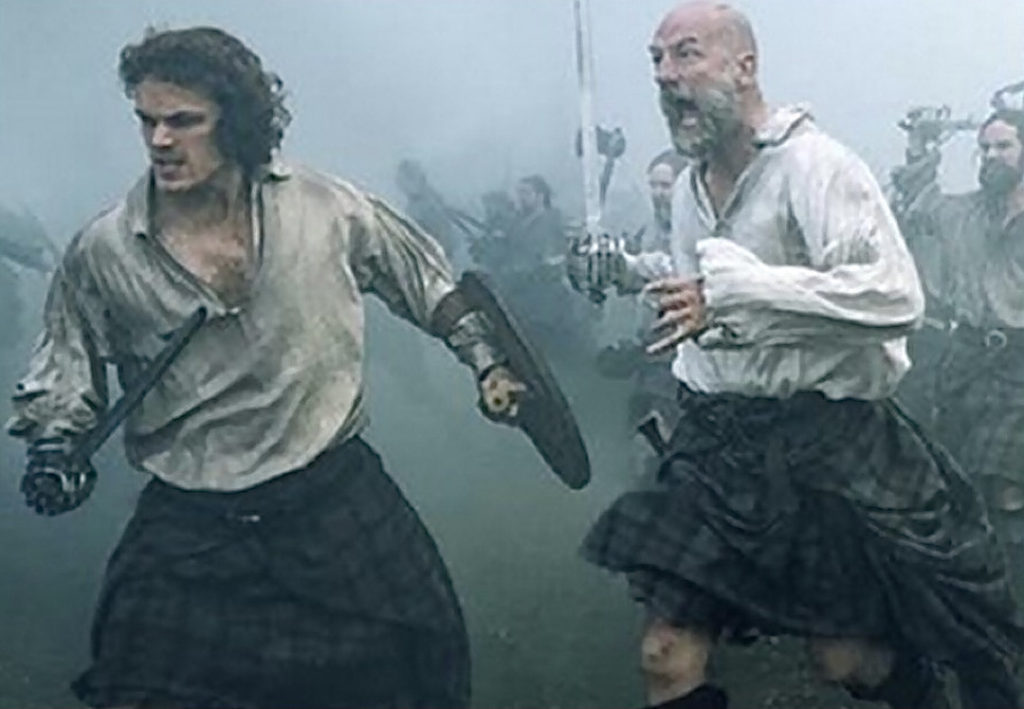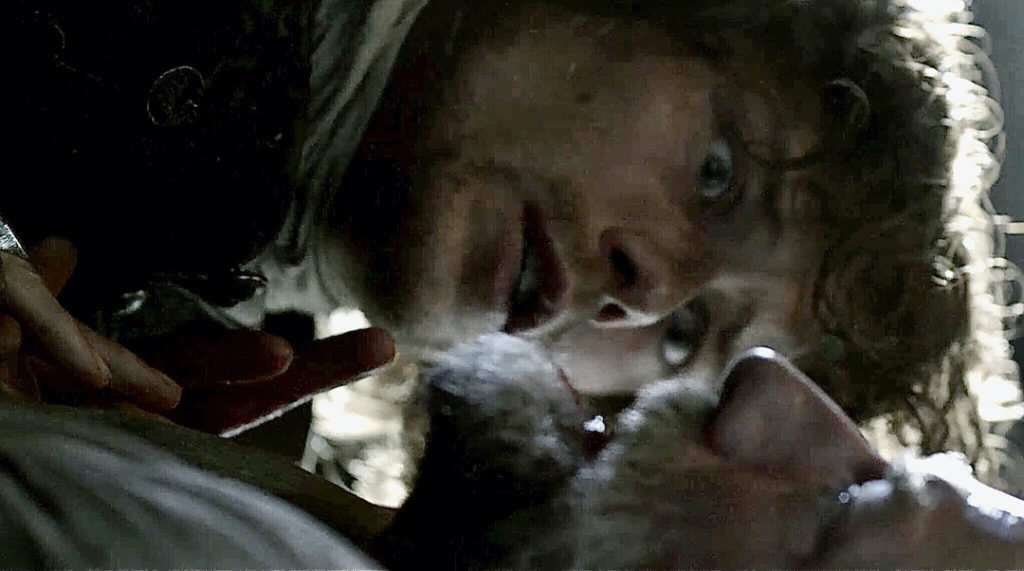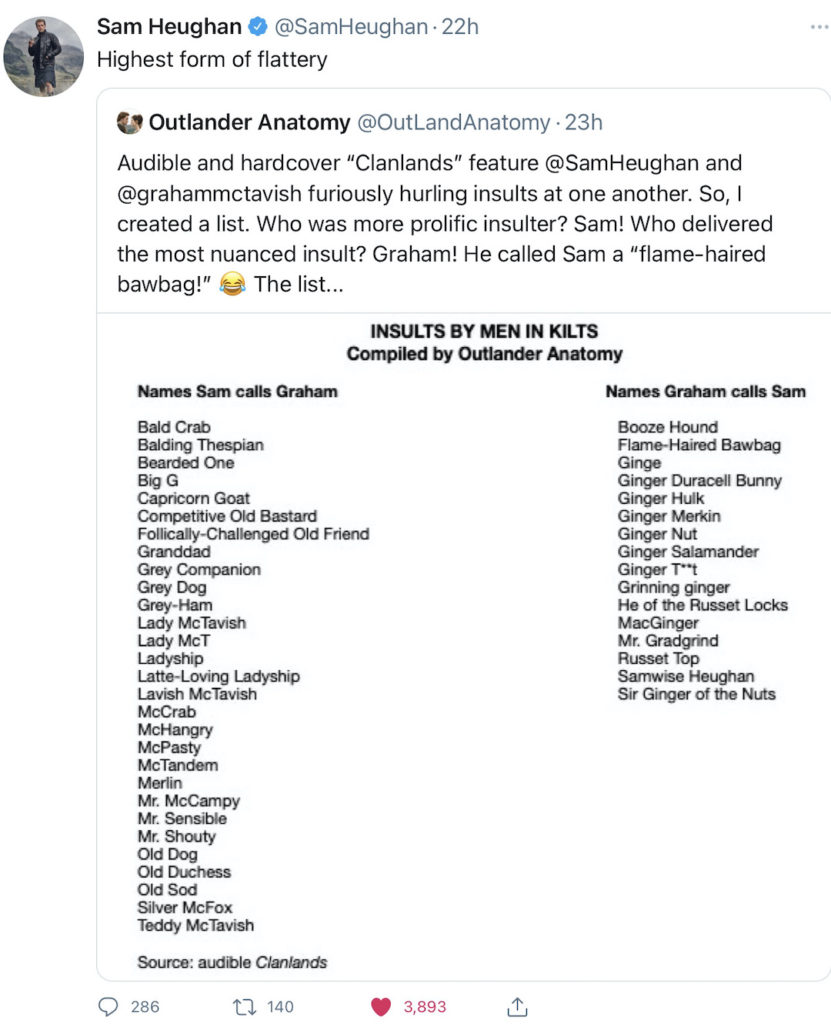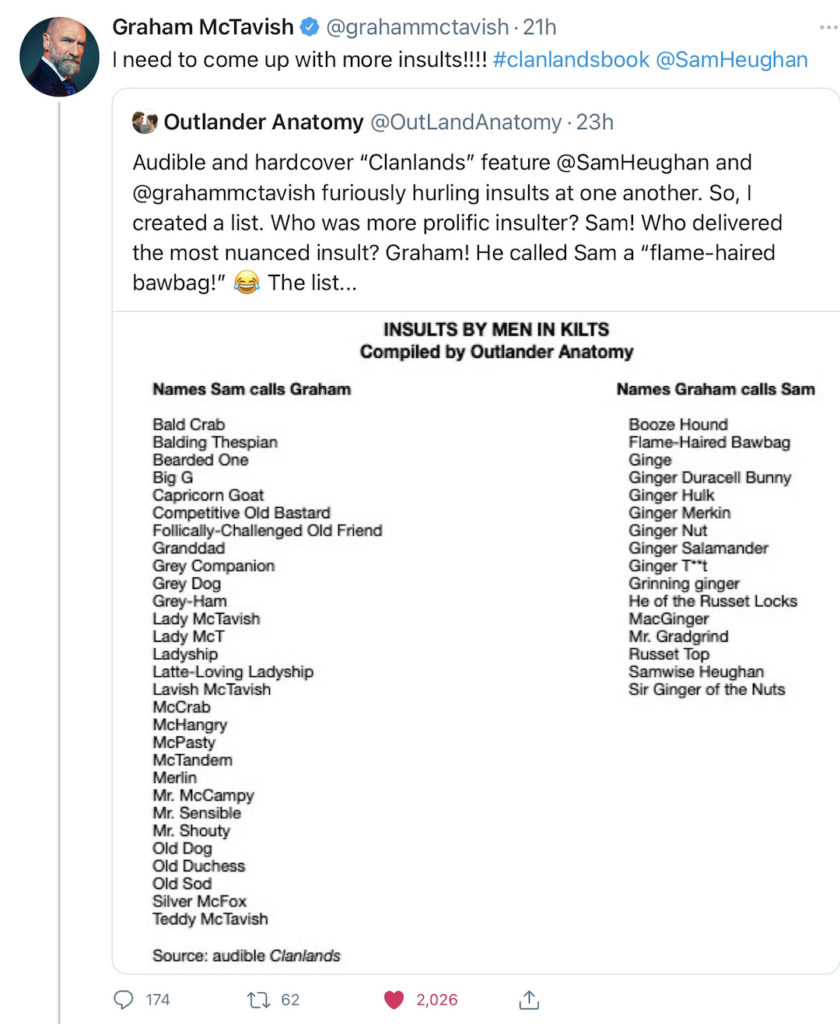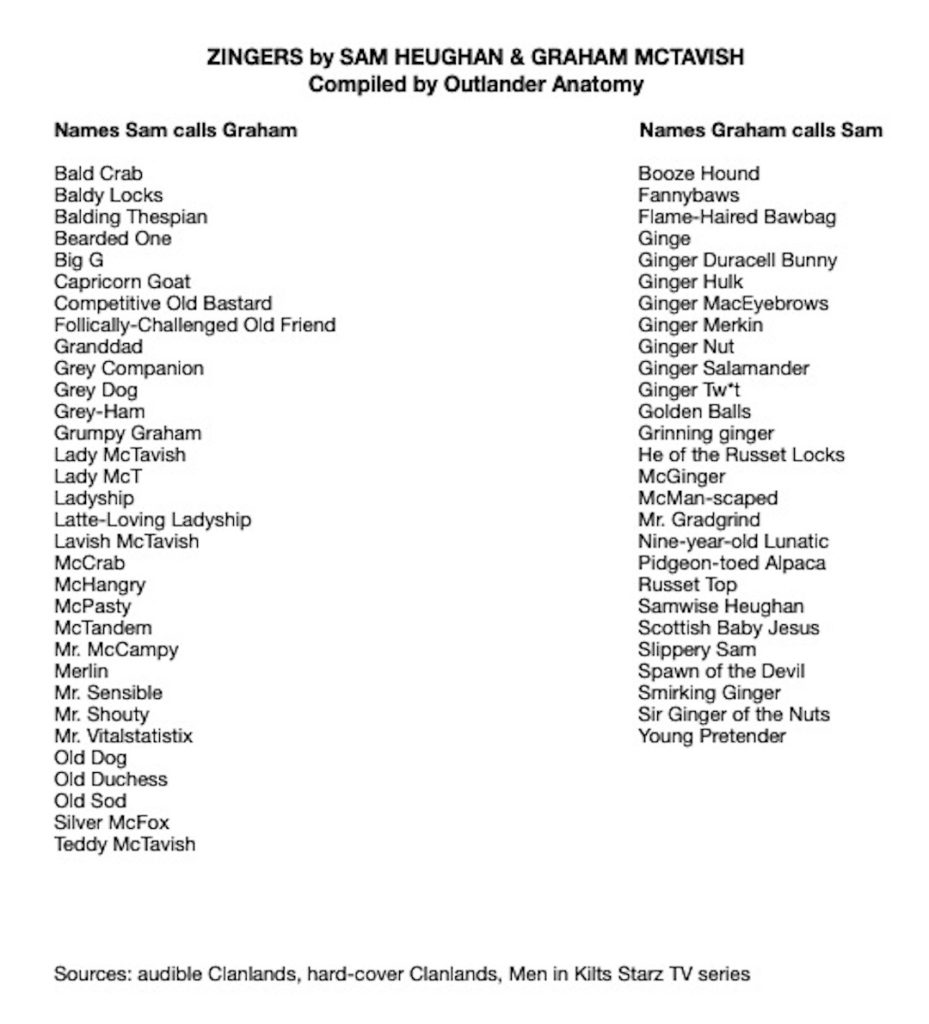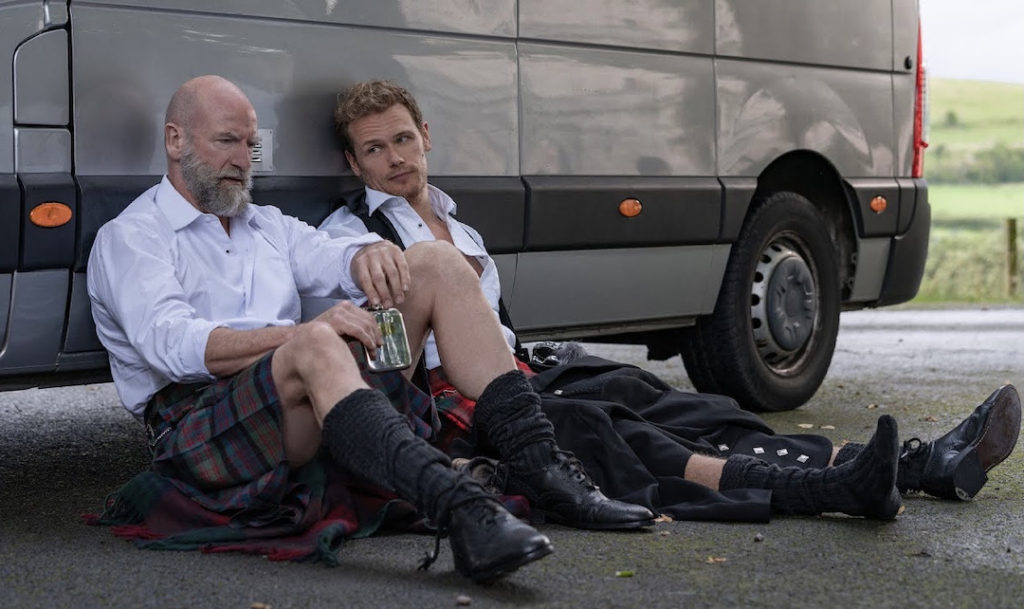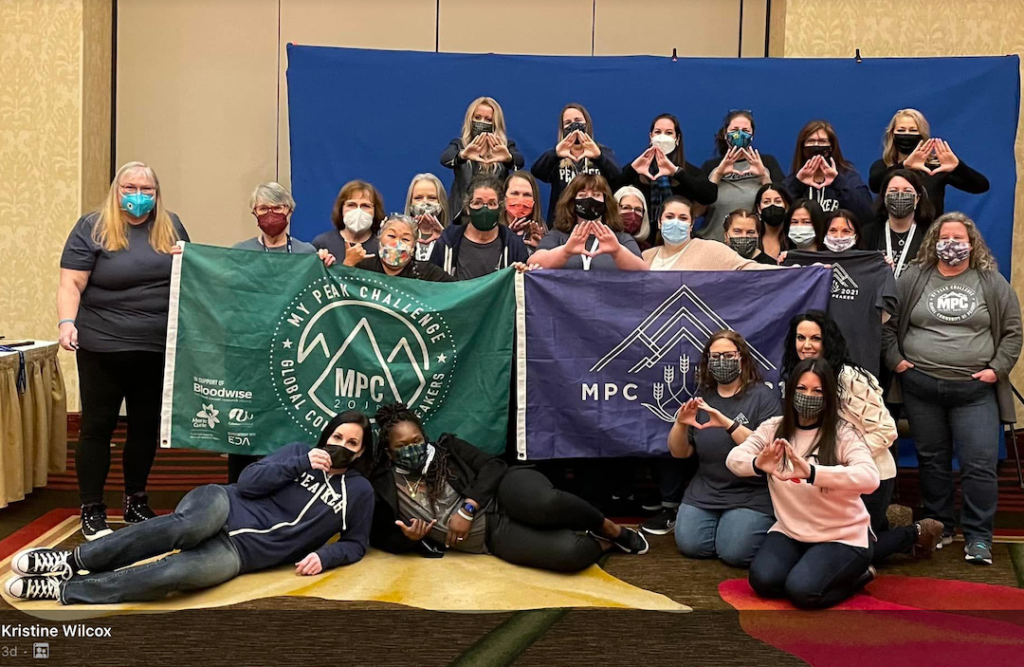
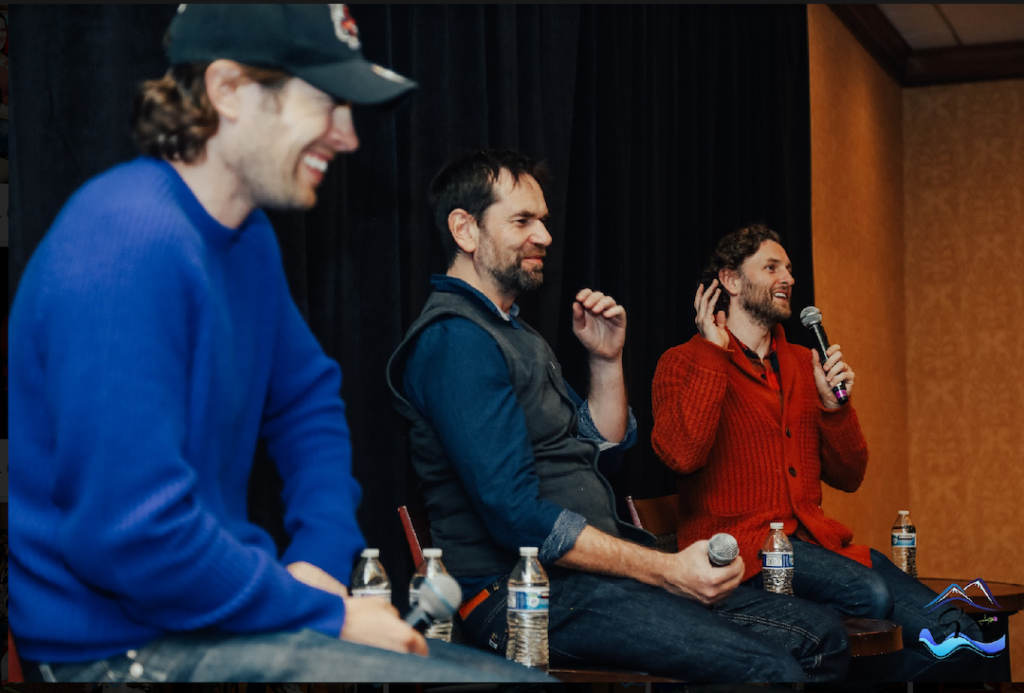
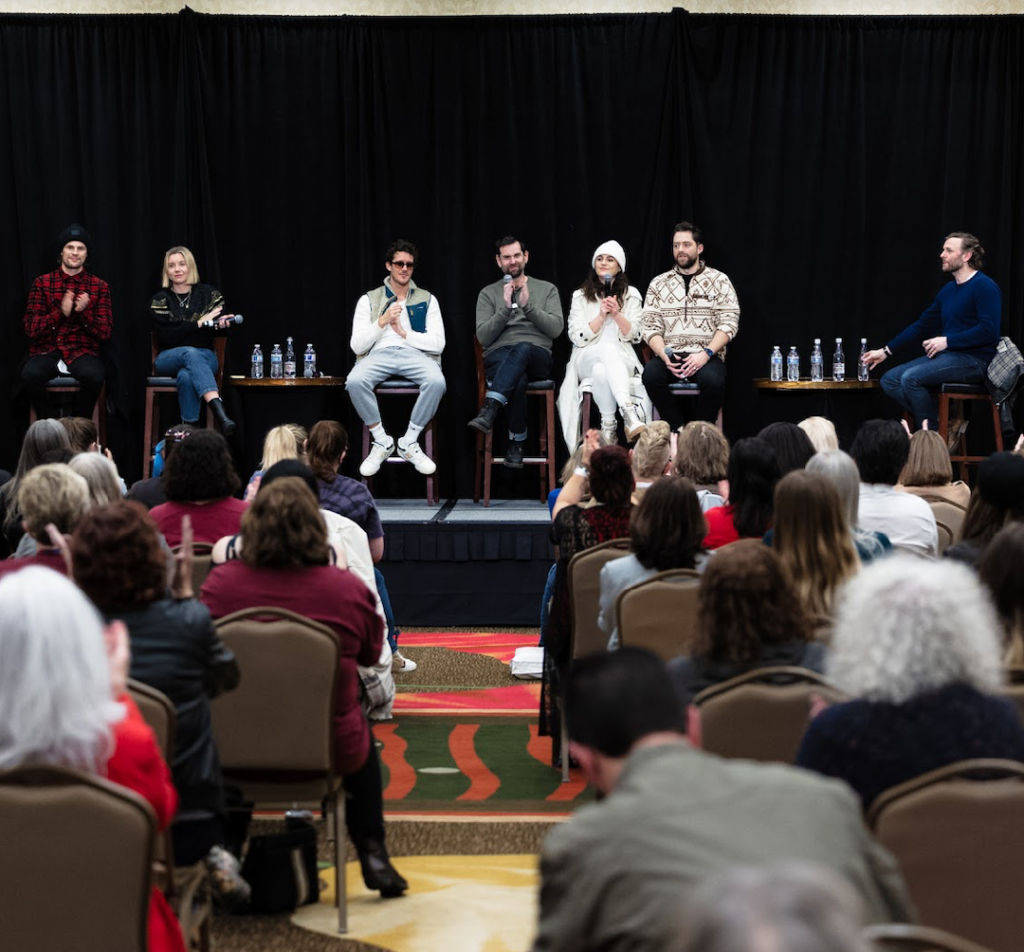
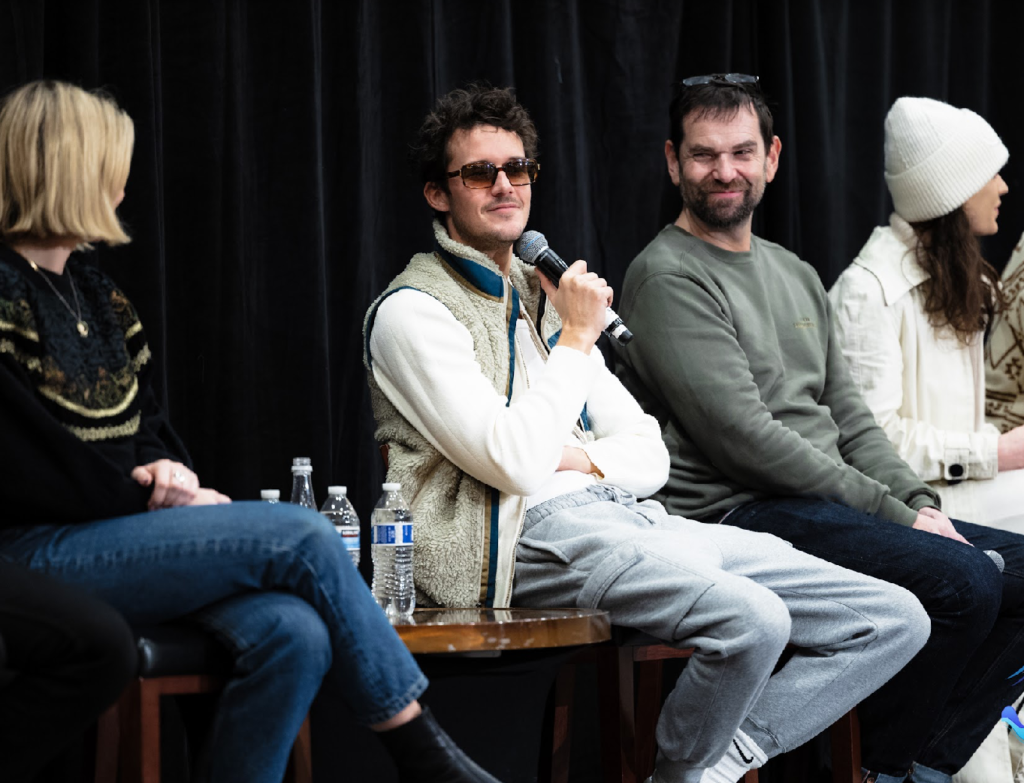 Greetings, all Outlander fans! I just returned from a three-day event (January 21-23), at Doubletree by Hilton Seattle Airport Hotel. Buckle up! This is a looong post!
Greetings, all Outlander fans! I just returned from a three-day event (January 21-23), at Doubletree by Hilton Seattle Airport Hotel. Buckle up! This is a looong post!
This was the long-awaited 2022 Seattle Adventure (OVSA) sponsored by Outlandish Vancouver, an event that typically occurs every October in Surrey, B. C., but sadly was postponed due to COVID.
Just so you know, all attendees were required to be fully vaccinated, boosted, and show a negative COVID test within 48 hours of check-in. Fortunately, my roomies and I were good to go!
It loomed large for us three roommates arriving from Oregon, Hawai’i and Washington, respectively! Jody KC (O’ahu) and I were first to arrive.
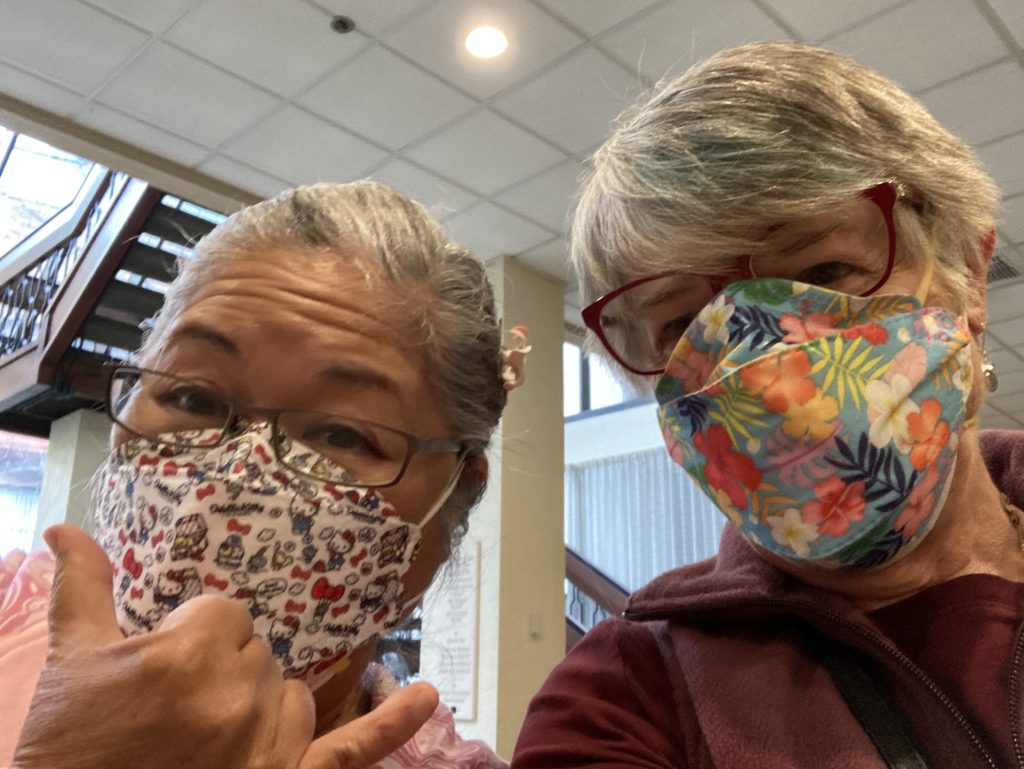
My new acquaintance, but a friend of Jody’s, nurse Ally, joined us the next day!
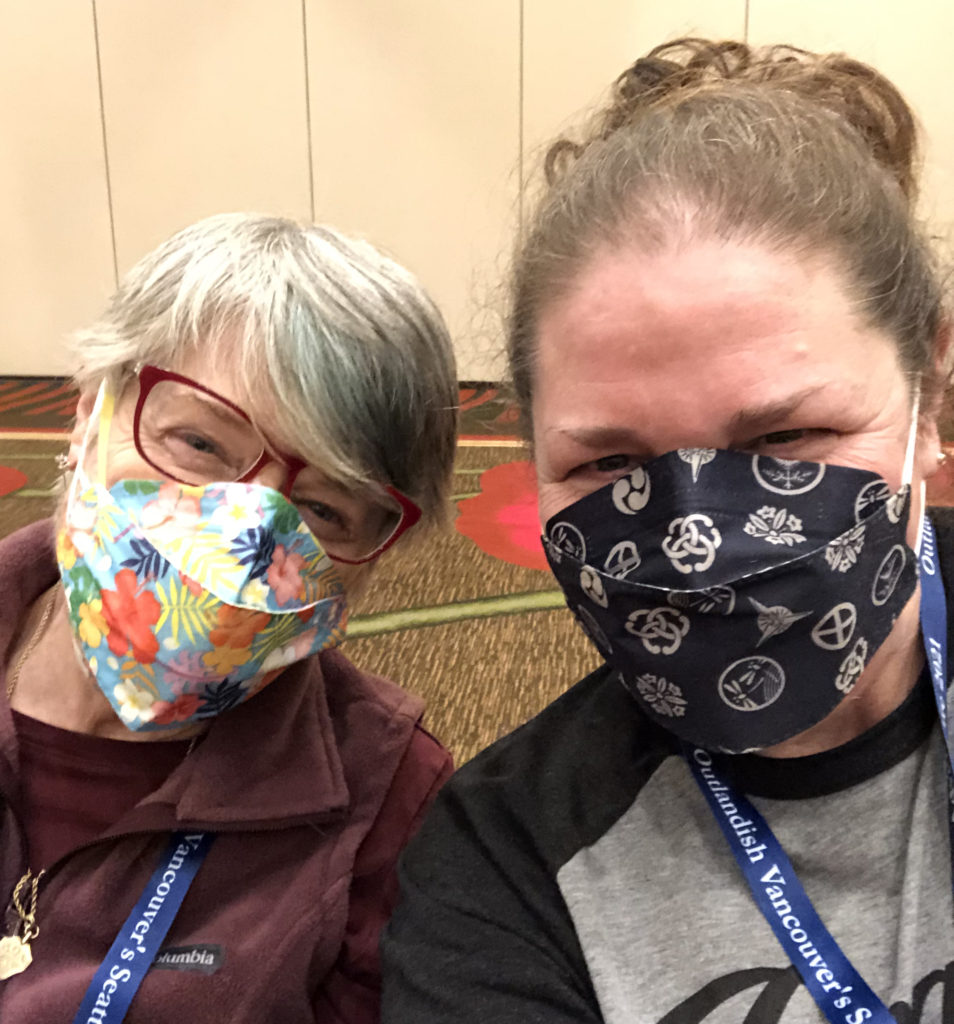
Before the event even started, guest Steven Cree shared this clever video on Instagram. And, this was just the beginning of his wry wit displayed at the event!
Friday afternoon, we headed for the registration desk. Volunteers woman-ed the tables so registration was swift and efficient.
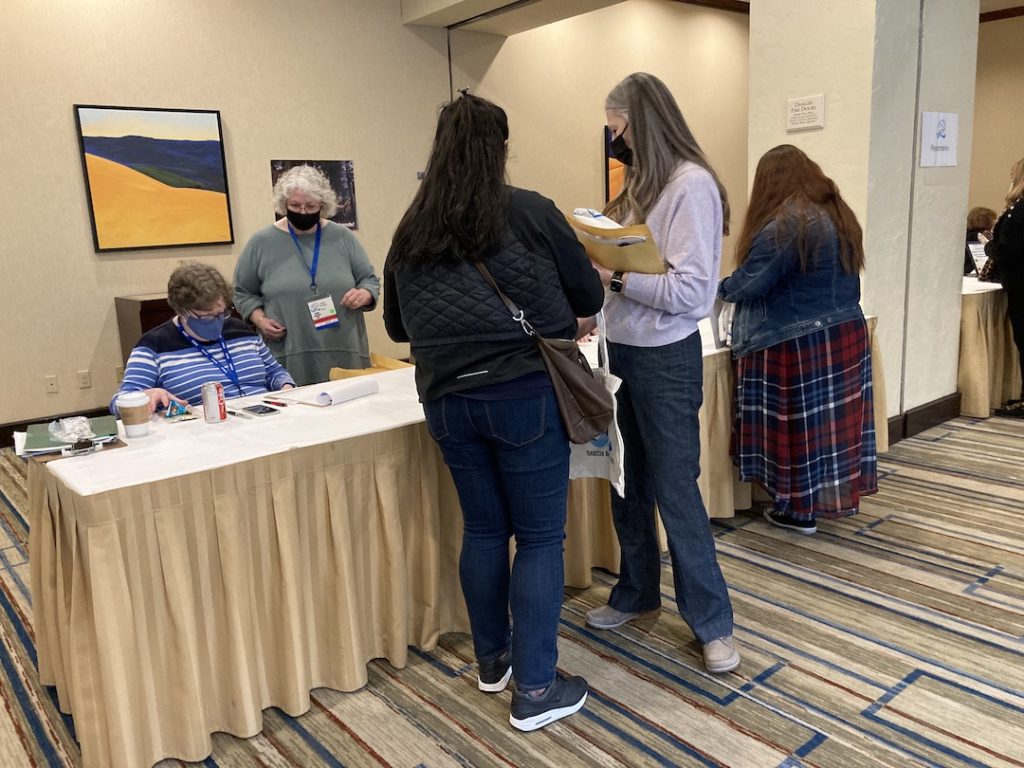
Soon, we walked away with lanyards, badges, and tickets for photos and autographs.
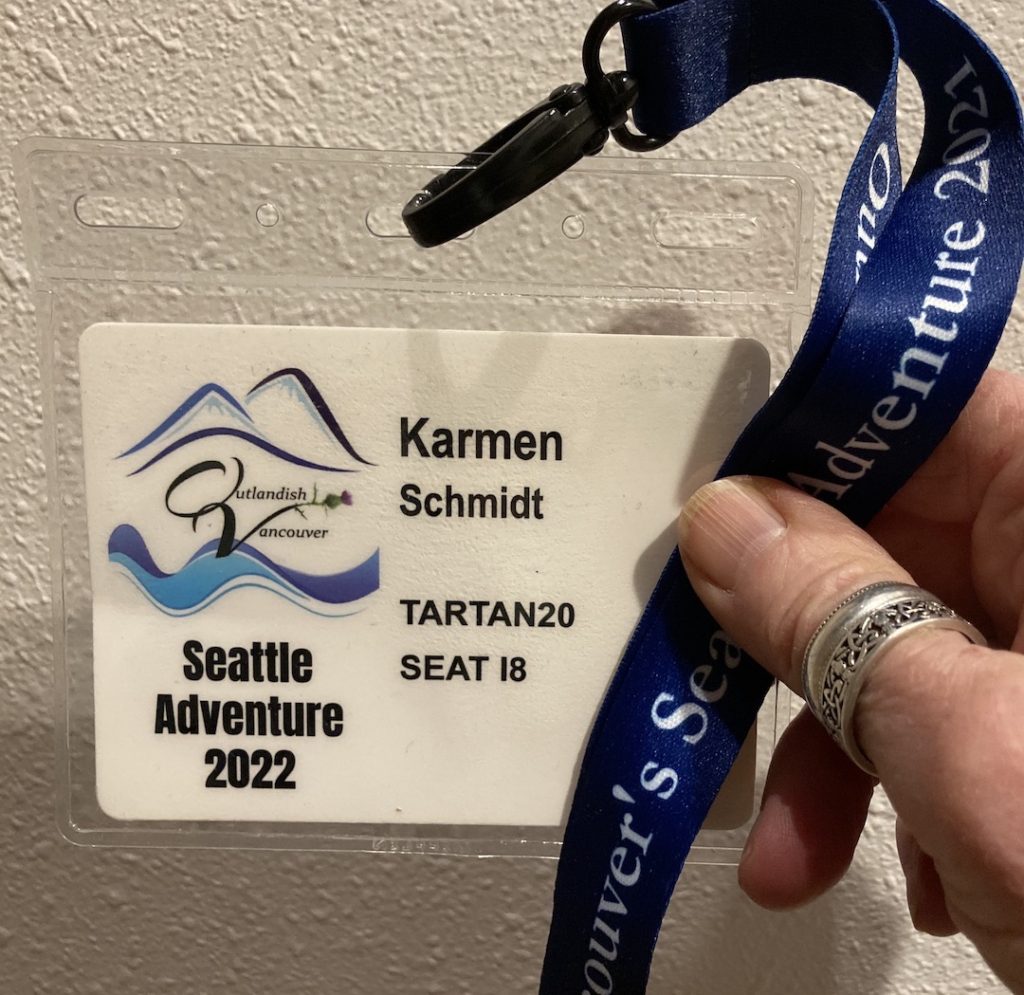
Barely got into the common room before this bad dude tried to steal my badge! Arrgh, matey!
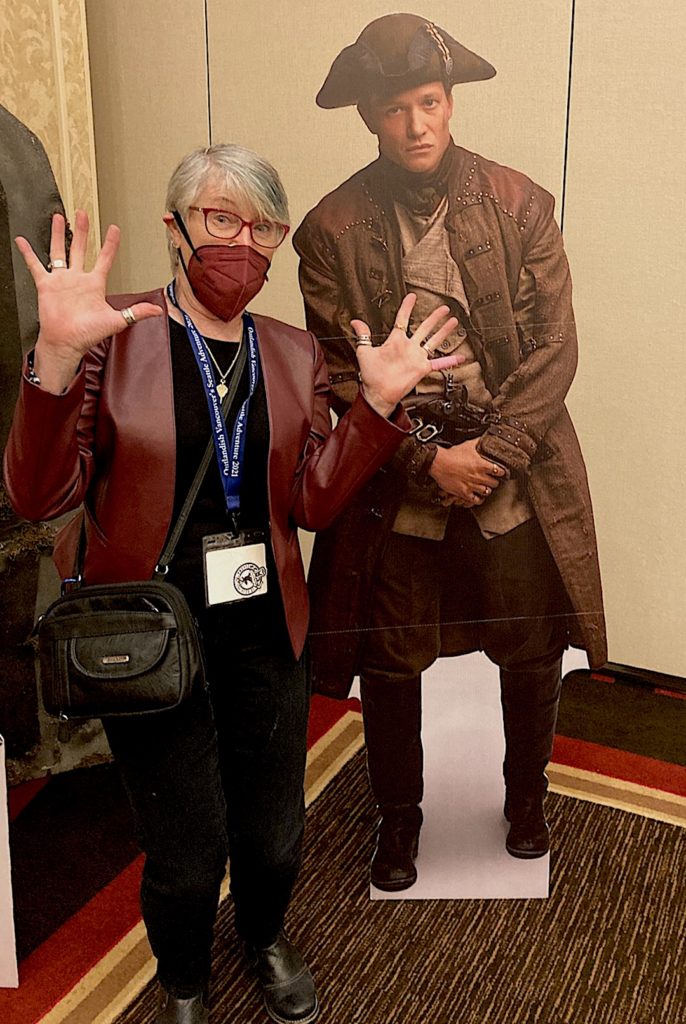
We were reminded by Jamie and Dr. Claire to be careful of GERRRRRMMS, to wear our masks, to keep our hands clean, and to social distance where possible. But, dirty minds??? …. No problemo!
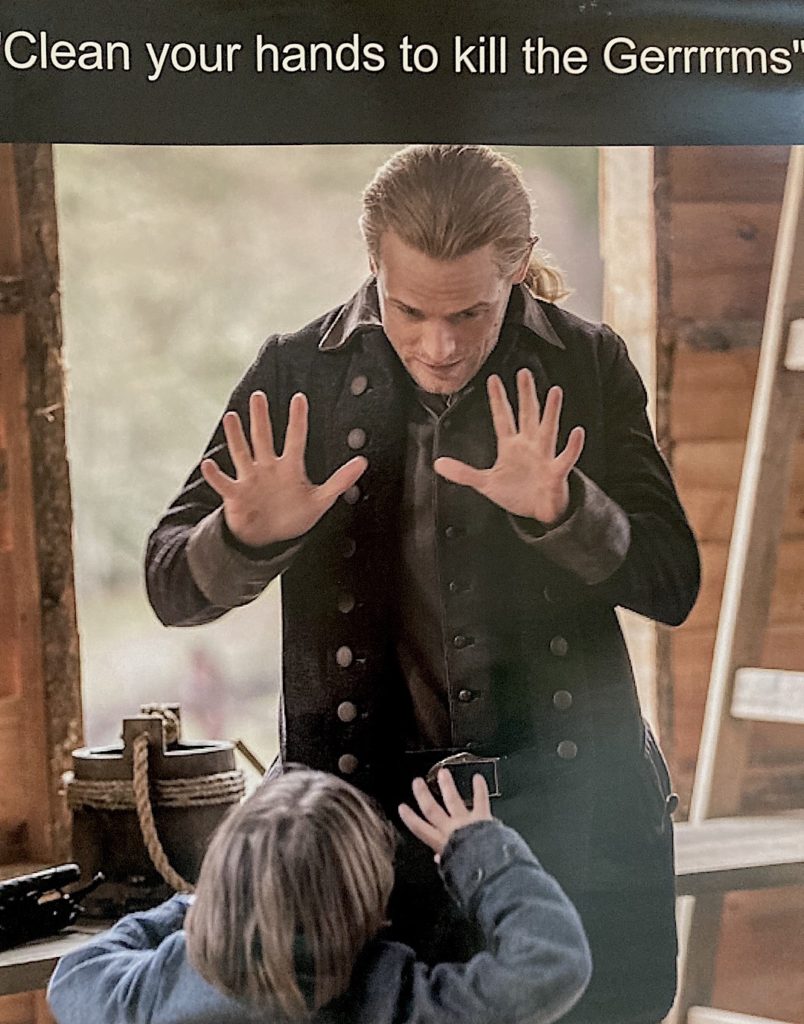
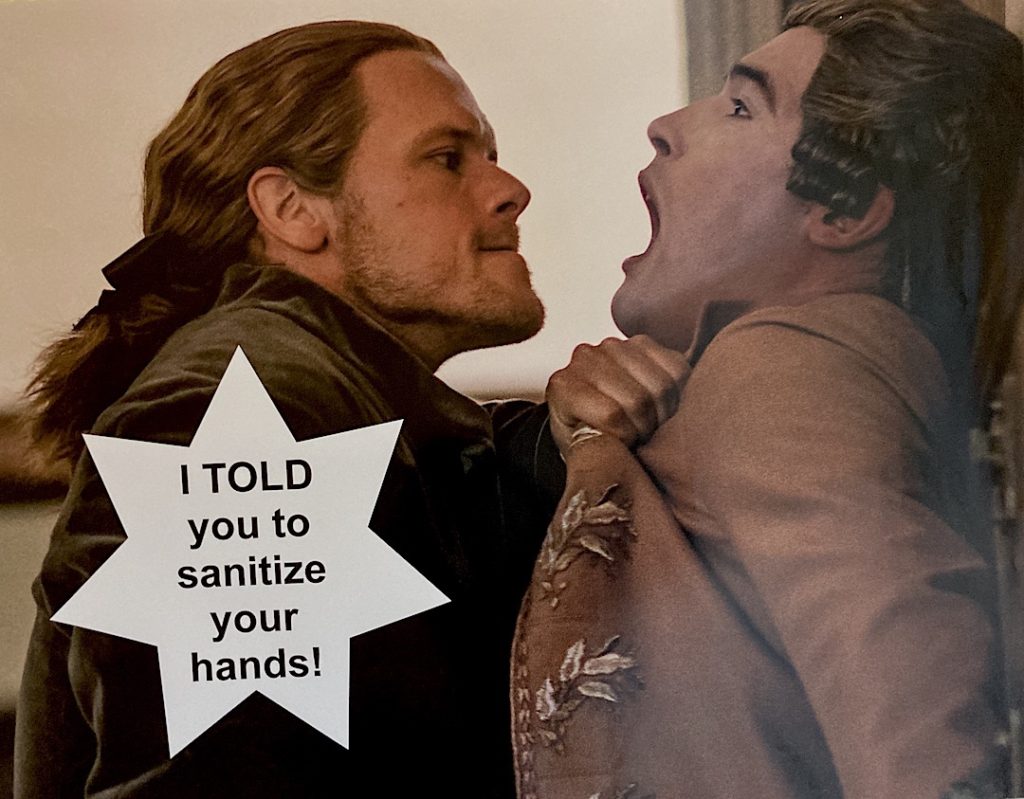
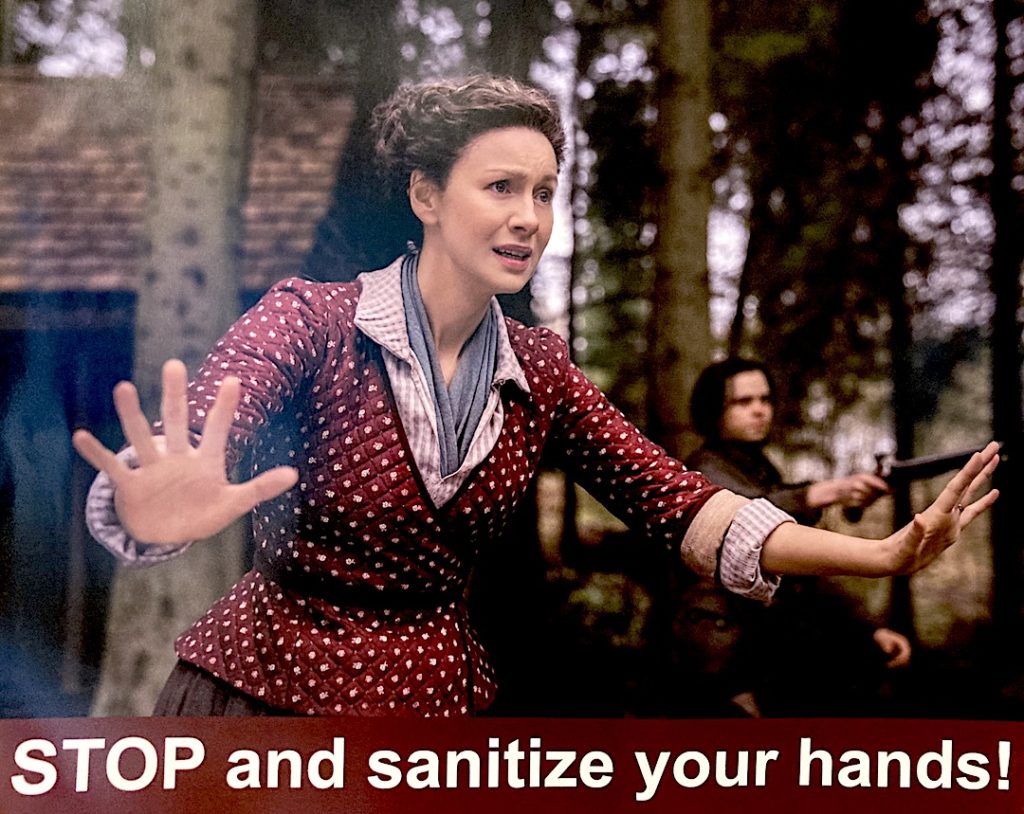
A lovely Vendor Row was open with Outlander-themed items for sale!
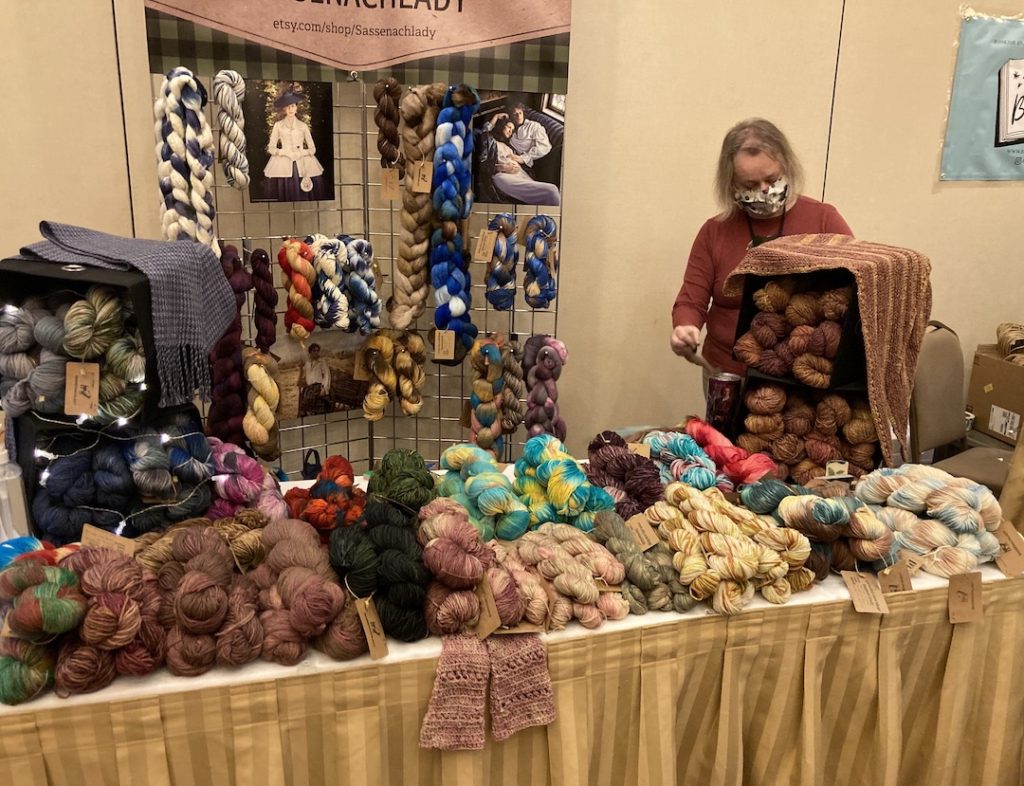
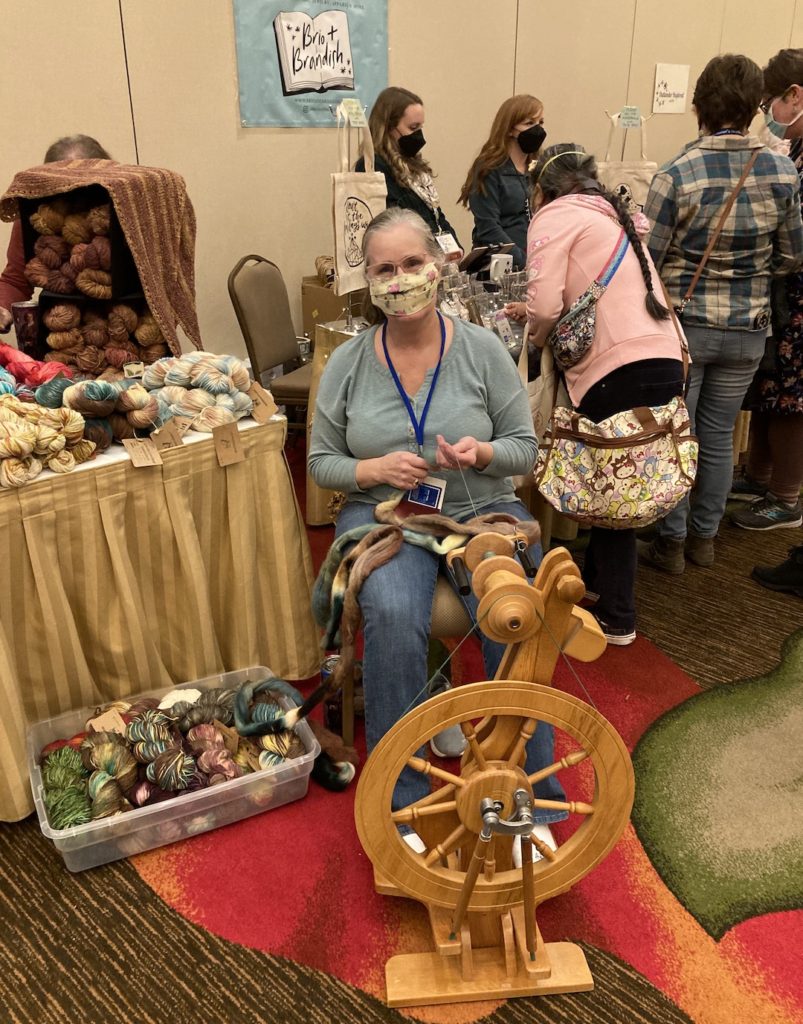
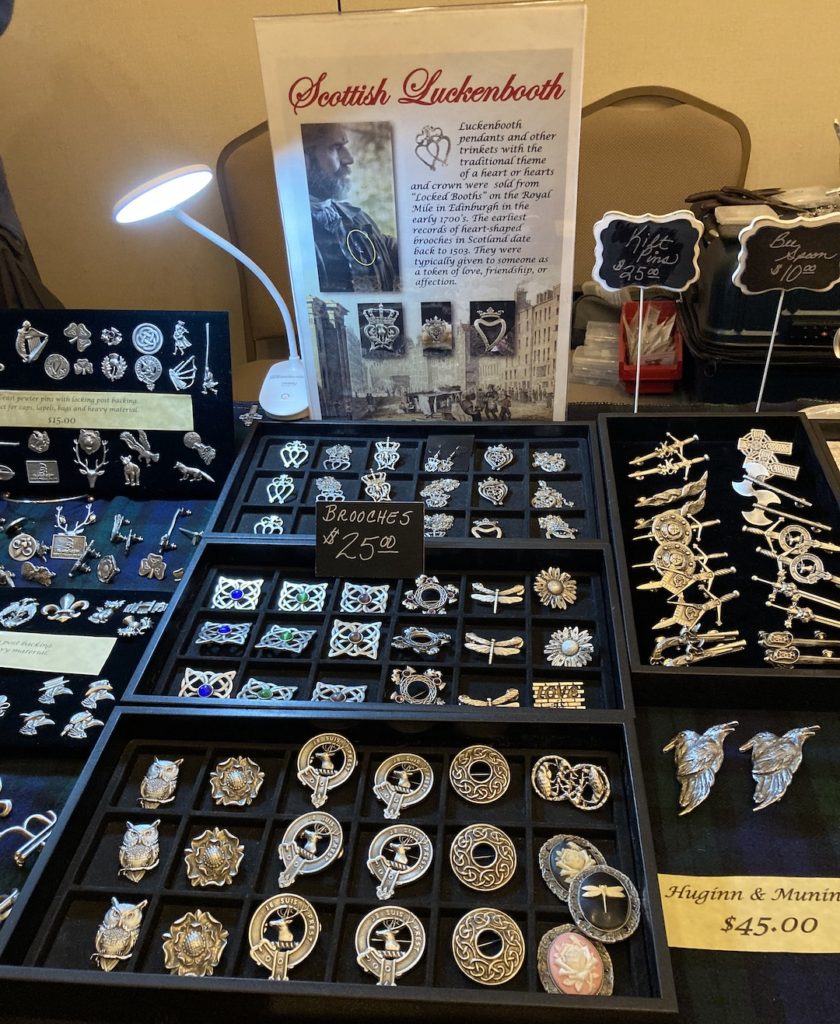
NOTE: Jody, Ally, and I pooled our memories, pen and paper notes, and nimble fingers working virtual keyboards to recreate the five panel discussions that follow. Hence, our “transcripts” are rough approximations of cast comments. Only the items in quotes are exact. Videotaping or audio recordings were strictly forboden at OVSA! 🚫
First Panel – Friday Evening
Koko Pipkin, the brains and force behind OV, was first to take the stage.
![]()
![]()
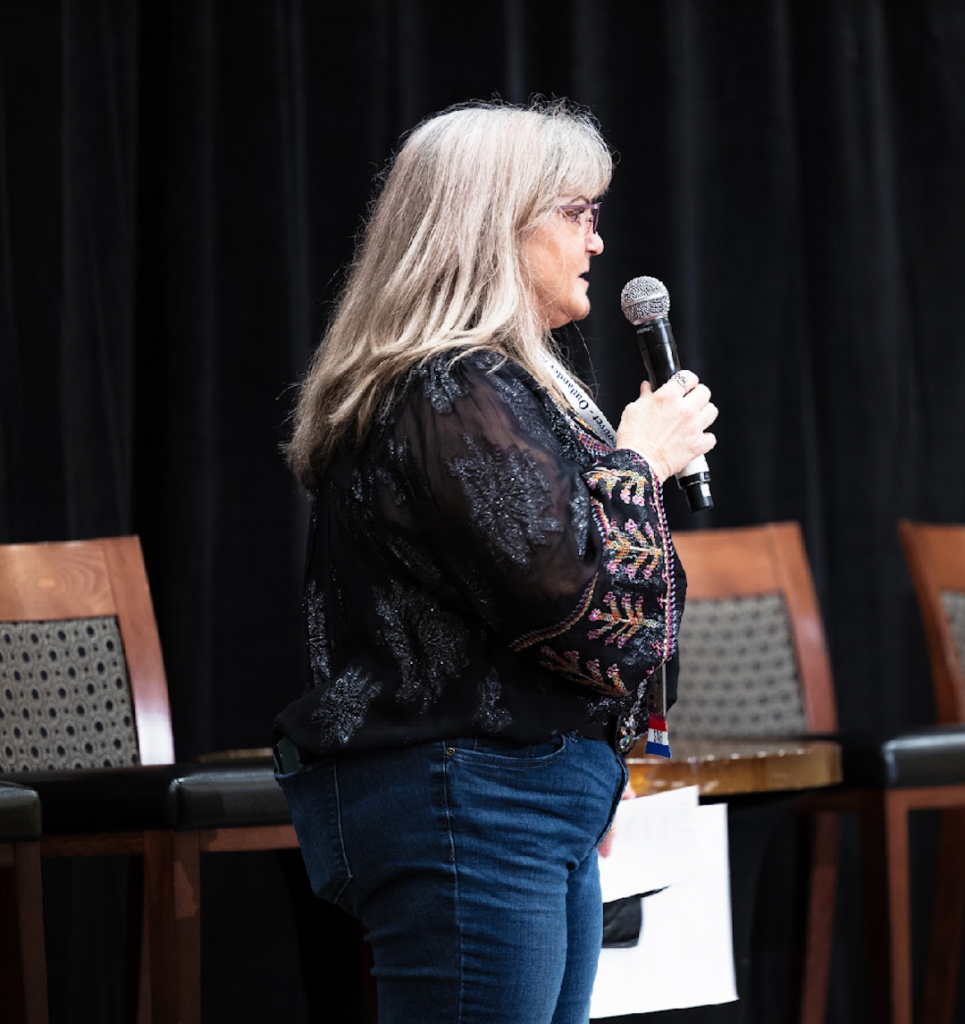
Koko introduced all seven cast members to a rousing ovation: David Berry (DB), Lauren Lyle (LL), Cesar Domboy (CD), Duncan Lacroix (DL), Sophie Skelton (SS), Richard Rankin (RR), and Steven Cree (SC).
The cast took their seats, set up in groups of 2, 3, and 2. But, Steven moved off to the side like he was hosting, AND TOOK OVER!! He didn’t dominate, though. Rather, he graciously asked each actor for their name.
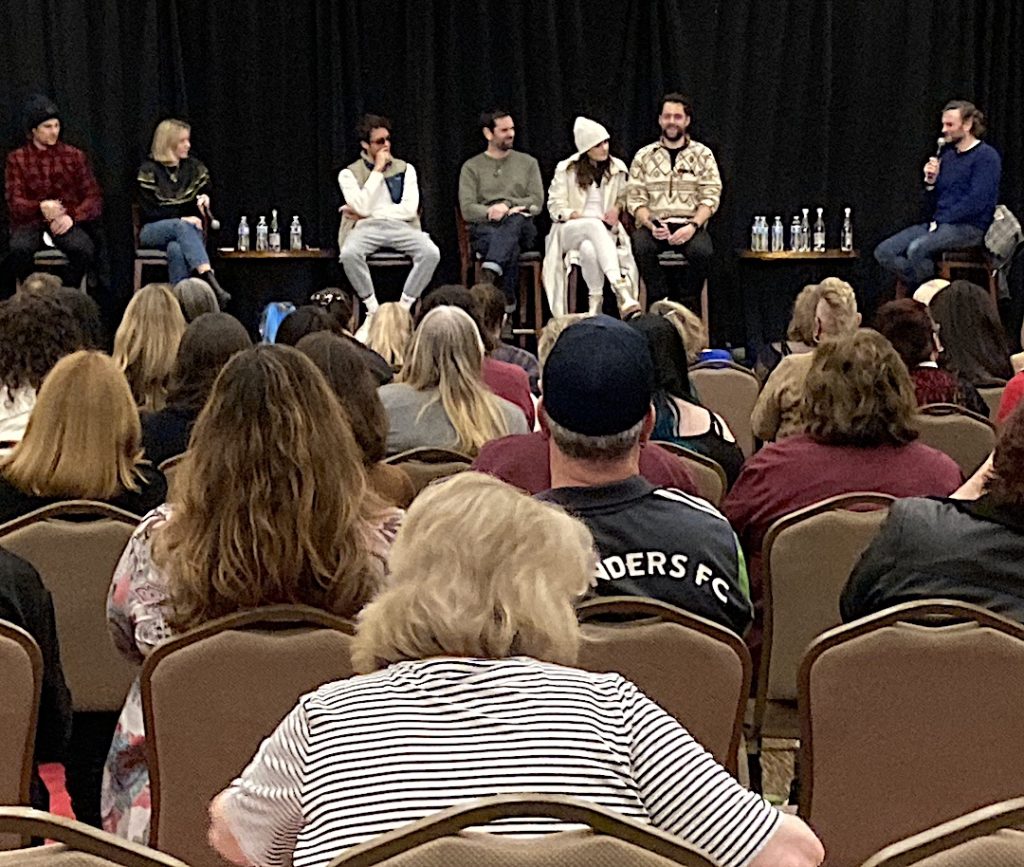
He commented on how CD managed to look cool 😎 no matter what or where (Cesar wore shades – it was nighttime and indoors!). Yep, he is cool!

WARNING:
The audience was enthralled!

Steven served as fairly raunchy host so please bear that in mind before reading the following compilations of five different panels!
Steven kept the ball rolling and was nearly a one-man comedy show. He asked the cast for favorite things: RR: Richard loved the 2021 documentary “The Beatles: Get Back,” produced and directed by Peter Jackson. SC: Ten-year-old Steven saw Ted Neeley in the lead role of Jesus Christ Super Star in West End London. He instantly fell in love with theater! He was fascinated by Jesus and his story. “The epic-ness. I have seen the movie over 100 times!” DL: “A man gets lonely in the Highlands.” We had no idea what Duncan meant! 🤷🏻♀️
Audience questions were invited, fans lined up behind the microphone, and there were some good queries!
Q: What celebrities would you pay money to meet? DL: Graham McTavish offering to buy a round of drinks. SC: Ted Neeley the star of JCSS. “He was hung… Jesus.” 😳 DB: “Harry Connick, Jr.” LL: Best concert ever was Justin Bieber.
Q: Fav slang word or phrase: DL: “Orango” (referring to someone being an orangutan) SC: “Go take a flying fuck into a rolling donut,” “bolt yer rocket,” “tata subunit,” “your arse and parsley,” and “piss off!”
Q What kind of animal living or dead would you want as a pet? DL: “Rat.” LL: “Woolly mammoth.” SC: “Cross between a shark and angry chimp.” 🤪
Q: What celebrity would you like to meet in person? SS: “Taylor Swift.” LL: “Jesus.” DL: “I saw AC-DC at 12 y. o. Big impact!” (That wasn’t the question, Duncan!)😜
Q: Does costuming help and how does it influence performances? LL & SS: Corsets suck! They cause chafing, sore ribs and hips, and bruising. And, it is hard to eat wearing a corset!
Q: Will we see Laura Donnelly (Jenny) in coming seasons? LL: Laura will be coming back! What??? The audience went wild and then, it turns out, Lauren was joking! 😬 But, the cast all agreed that Laura’s return as Jenny is unlikely. 😢 SC: He met a lovely attendant on his flight over and had a nice chat. Next day, met same flight attendant at Pike Street Market in Seattle! “Incredible!”
Q: Fav leisure activities during COVID? SS: Long walks. Laura and Sophie then bantered about long walks – more than an hour? Less than an hour? It remains a bit obscure. CD: Playstation! He considers himself to be a master chiller. LL: Loves working with Cesar. They were on the phone or FT daily during lockdown. (They truly do enjoy a warm and wonderful friendship, like brother and sister!) CD: He and LL like the same food and eat off each other’s plates. RR: Likes Sophie’s laugh!
Q: Fav music: LL: Loves the S6 Outlander trailer music and any funky-pop-sync music. CD: Anything that sounds like melted cheddar to his ears. 😆 (Someone liked Jim Morrison in leather pants but I didn’t catch who. Sorry!) SS: American country music RR: Beatles and John Williams (Quite a range!) SC: Beatles and musical theater. Steven claimed he “feels music through his bones and out his ass, but that might have been Sam Heughan’s finger!” (I warned ya!) 😮 DB: Classical to jazz, all genre.
Saturday morning was devoted to photos with cast members. This is my favorite! 🥰
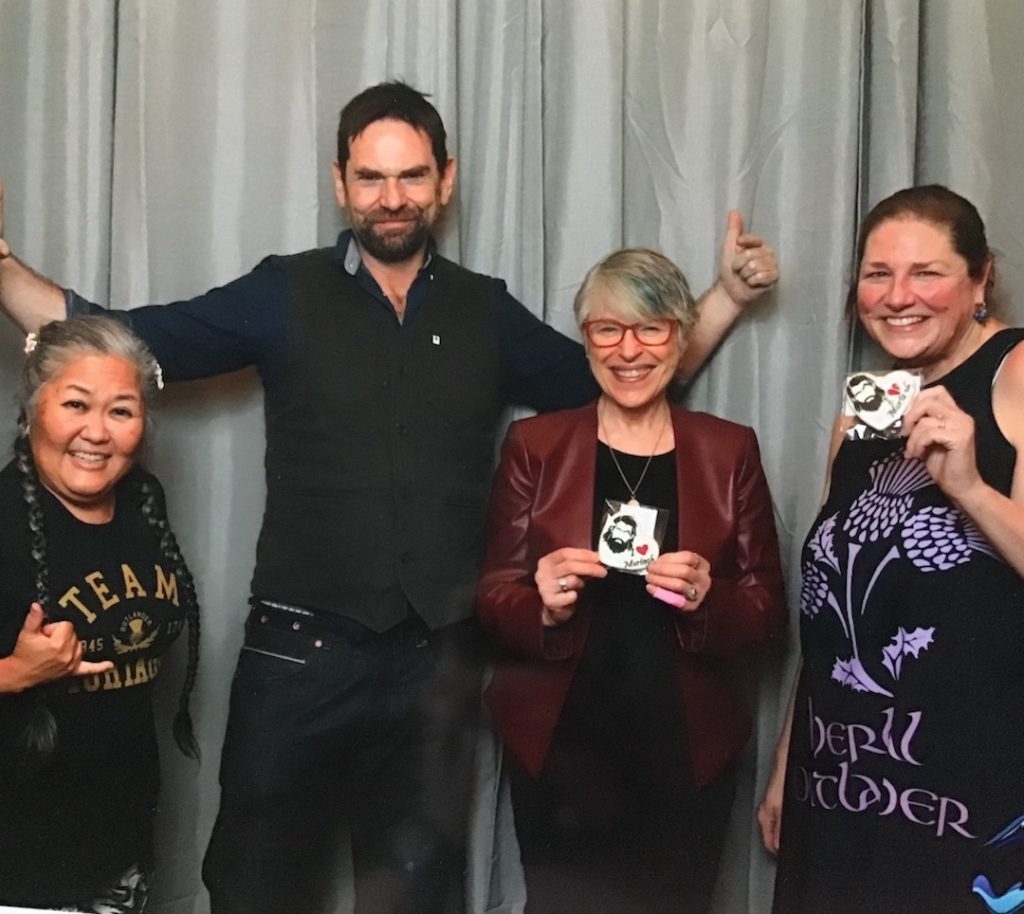
Many members of My Peak Challenge, known as Peakers, attended the conference. This is Sam Heughan’s training program. Later that day, we gathered for a group photo. All devoted to healthier living, exercise, and community!

Next Panel – Saturday afternoon: DB, DL & SC

Another Q and A session, and believe me, there was no paucity of questions. The fans came prepared! After introducing the guys, SC said we were going to start off with Koko stripping! (Puir Koko – she was such a good sport!)
Q: What was Murtagh thinking when Jocasta threw the glass of whisky in his face (ep 413, Man of Worth)? Please be specific! DL: Murtagh got tingly all over from head to toes and there WILL be something done about it! (Pssst…..There WAS something done about it!)
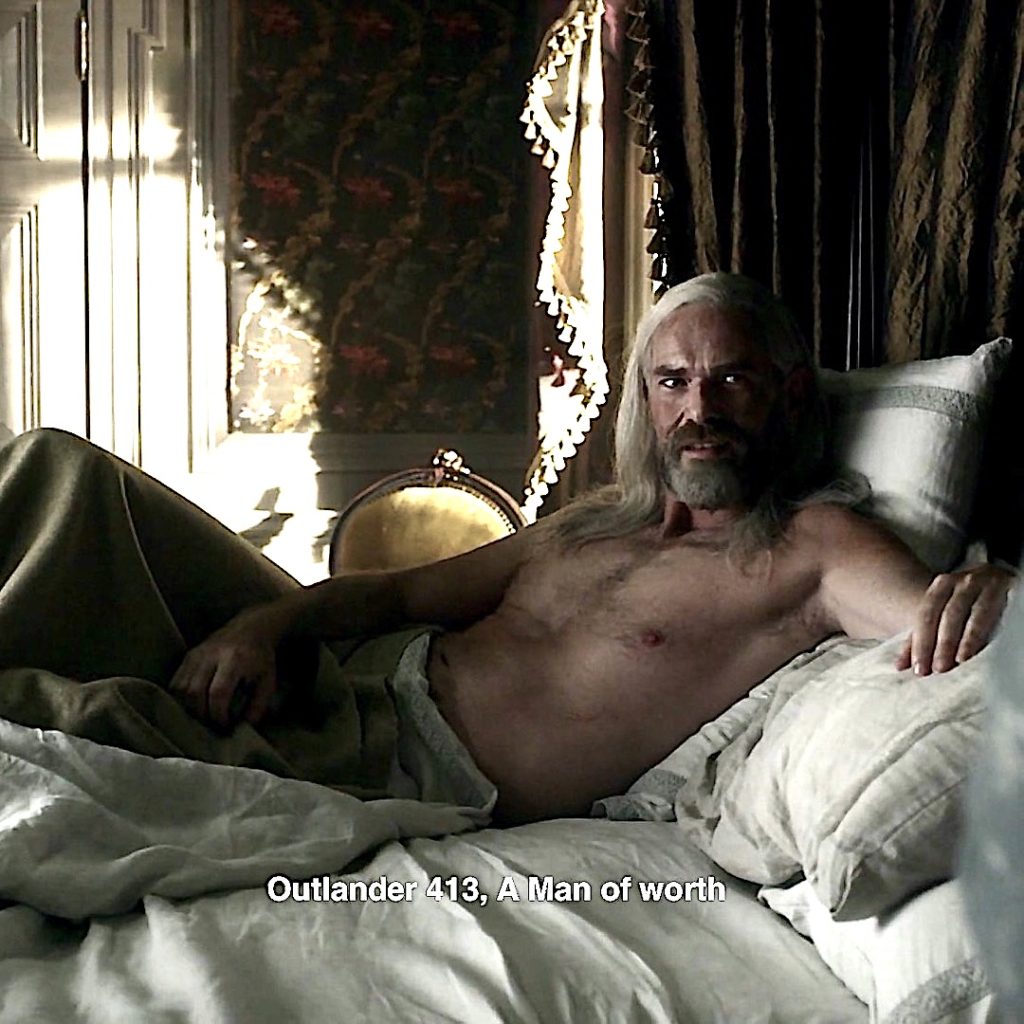
Q: Will there be a LJG spin-off? DB: I cannot talk about it. I cannot say. (Hmmmm….. 🤔) SC: You can see it at pornhub.com!
Q: Any line flubs? SC: Steven was waiting for the director to call “cut” after finishing a scene with Cait (ep 112, Lallybroch), but no one yelled “cut” so the cameras kept rolling. Steven was uncomfortable so he grabbed a head of cabbage off the table, handed it to Cait, and said: “Stuffed cabbage, Claire?” His clever ad lib made it into the show. Check it out!
Q: David, what happened with Lieutenant Leonard (Charlie Heitt, ep 313, Eye of the Storm)? Leonard was the de facto Captain of the Porpoise but Lord John addressed him as Lieutenant Leonard. DB: In the confrontation between LJG and Captain Leonard over whose power was paramount, David accidentally called him “Lieutenant” Leonard. This lucky slip-of-the-tongue was kept because it came off as intentionally putting Leonard in his place. 👏🏻👏🏻👏🏻
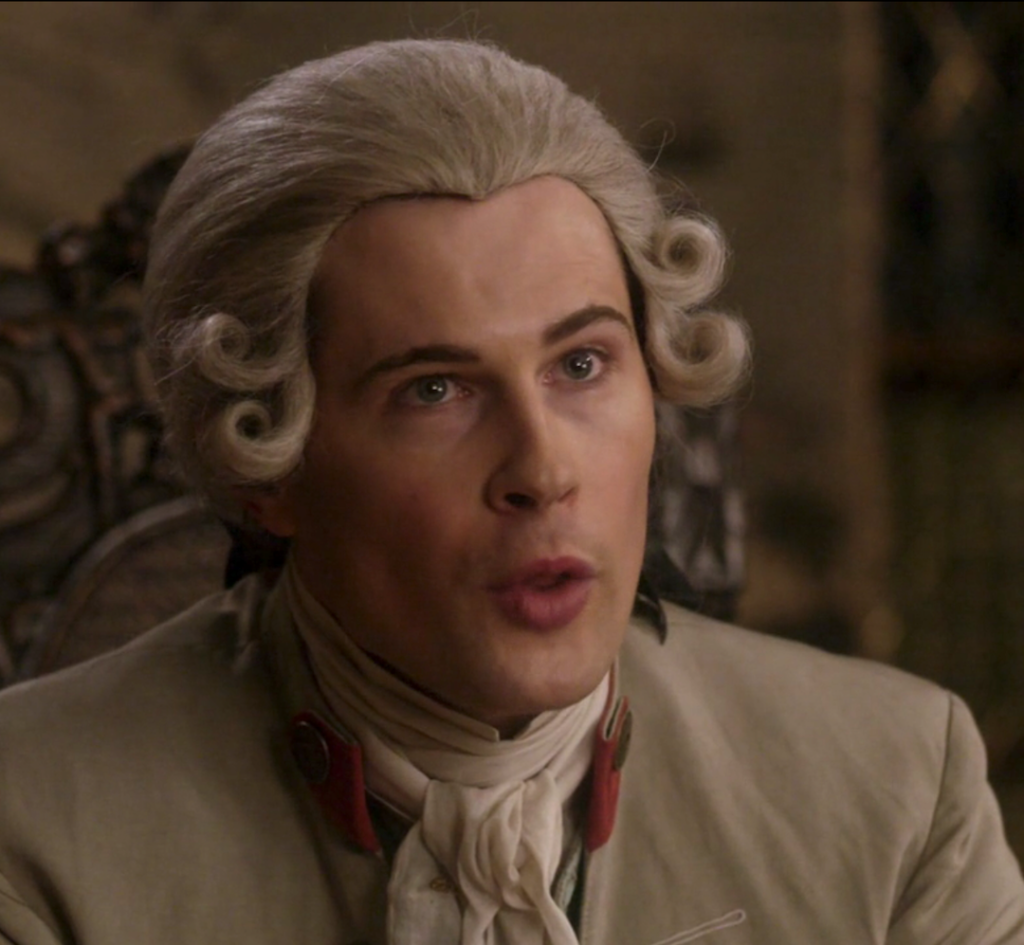
Q: What do all of you think of the way slavery was depicted in Outlander? DL: Duncan said he was uncomfortable with the way slavery was filmed and would have preferred if modern sensibilities had been added to the show.
Q: How did you cope with Outlander? DB: “Lots of alcohol!” SC: “All actors are insecure and want approval.” He prefers getting compliments much more than “You are a f**king shit!” And, flying from one continent to another is not a hardship. DB: Hard to take so much attention. We may need it but it is also difficult. SC: Graham likes being on a pedestal. (What???)
Q: What are you afraid of? DL: Water and diving lessons. “I am a – what you call it? Aquaphobe? Aquaphobic? I would overcome it if it were for a role.” (fear of water is aqua-phobia). SC: Sex scenes and horses. “Sex scenes are hard!” He told us “Outlaw King really taught me to respect horses. I’m like how is this gonna go?” He was referencing an epic scene involving horses, riders, and trees. A stunt rider fell off his horse and got dragged, and had to be air-lifted off set and replaced by another actor. Steven was scared he’d get hurt. DB: People who think you are competent in an area just because in a show you acted it! 😯
Q: Most awkward scene? DL: Sex scenes with Jocasta. He thought he would be on top. <G> “Keep moving” the director said. “Hope you enjoyed it , Jo. I know you are blind, but!” 😱 DB: Sex scene with someone you had never met before (ep 411 – If Not for Hope). This was the pantry sex scene wherein the director asked them to “settle it down,” they were making too much noise!
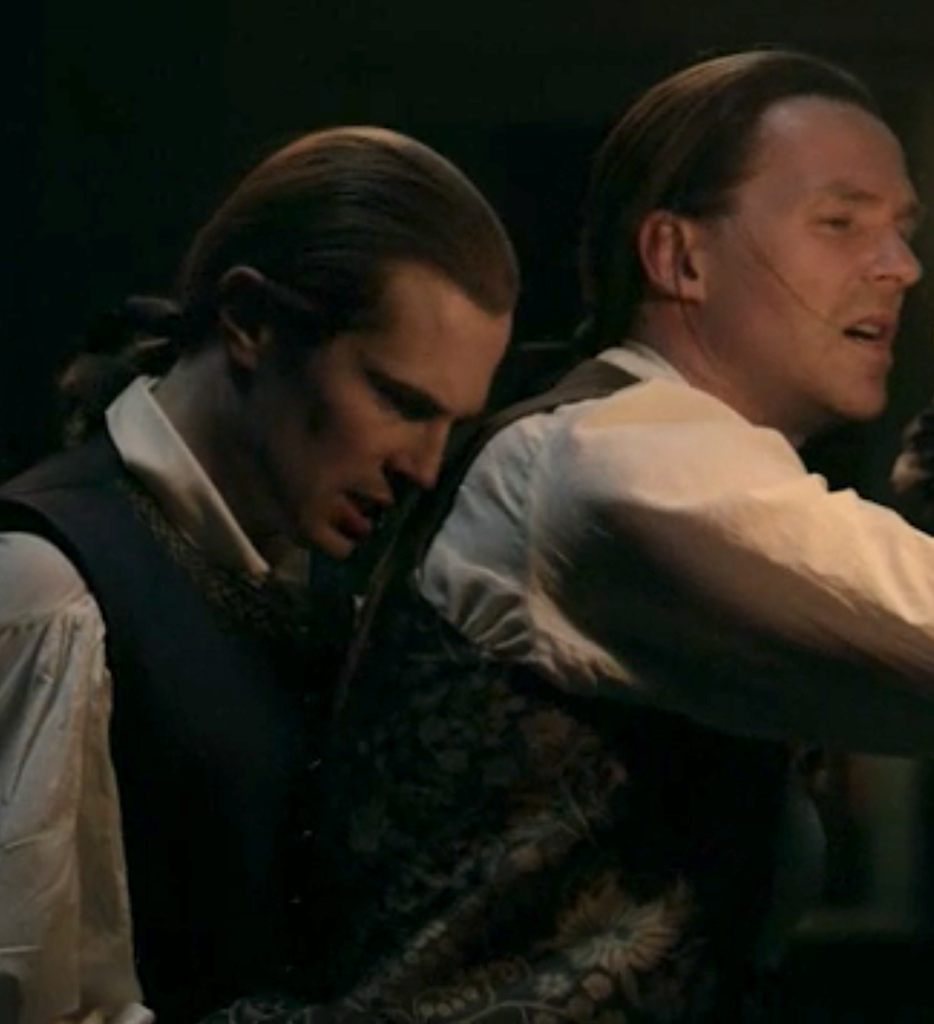
Q: David, will you bring back the podcast with Tim Downey? DB: No. They are done.
Next Panel – Saturday afternoon: Lauren & Cesar
The cheerful cuties came on the stage and we began another round of questions. This excellent format really engaged the audience and encouraged participation! Everyone seemed to love it!
(Psst…the photographer looks as if he is praying at the altar of Fersali!)
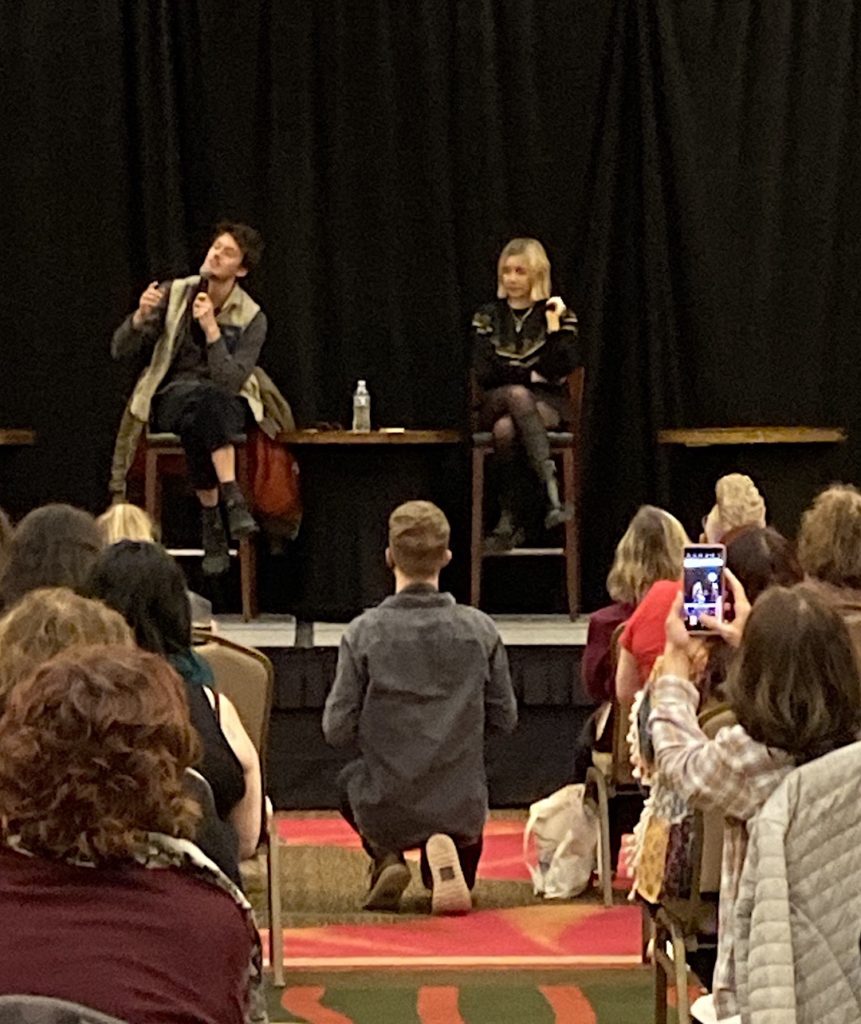
Q: Which scenes were ridiculously hard to film? LL & CD: The locust scene (ep 506, Better to Marry than Burn). It was all CGI and we had to shout “locusts” and beat the air with rags when nothing was actually there! CD: An intimate moment giving birth in S6. Which wasn’t awkward at all. LL: In S3, the boats were on rockers. Director would shout “wave!” They were supposed to scream and throw up hands as crew threw water on them. It felt ridiculous.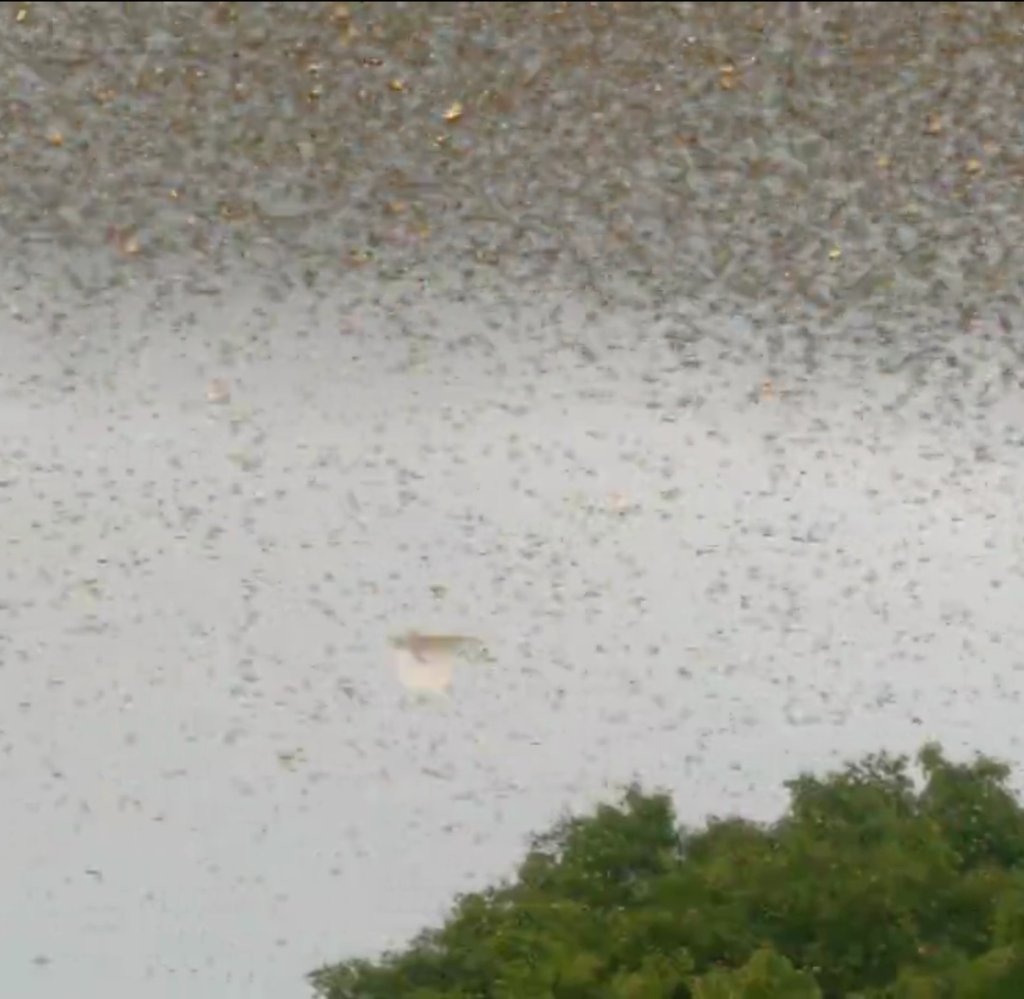
Q: What is the strangest thing you have been asked to autograph? CD: “Wooden hands.” 😁 LL: “Pictures of cats.” ( Apparently, lots of fans have named their cats, Marsali!)
Q: What do you look for in a new city? CD: Brunch places, good food. LL: Coffee – at Pikes Place Market, Starbucks on every corner, good burgers.
Q: How did you prepare for the birth scene in S6. LL: They haven’t really shown Marsali giving birth before. Maybe another baby is born and maybe it comes from me. We just look at each other and a baby appears. Actually, Lauren did a lot of research. Came across one 18th C. corset for nursing that had little wooden doors over the nipples – “ wooden doors for wooden hands.” 😅 CD: In S6 there is an intimate moment where Marsali is giving birth and Fergus is there. They had an intimacy coach for the scene. (Who knew?)
Q: If you could be a superhero, who would it be? CD: Deadpool, Star-Lord from Guardians of the Galaxy. LL: Katness (Hunger Games). One of the warriors from Wonder Woman. Loki. CD: “Poison Ivy.” (He didn’t say if he meant himself or Lauren!)
Q: Best attributes of the characters you play: CD: Fergus is likable and has a pure heart. How he handles trauma. LL: “No one liked Marsali, but I got people to like her and not Marsali-in-the-kitchen!” She has a real bite to her, able to hold her own. Fergus and Marsali choose to stay together because they love each other. CD: “I followed what Romann (Berrux) did to bring the freshness to Fergus and create an interesting arc from kid to a dark character.”
Q: Where do you go in the USA for snacks? CD: Shake Shack. Chocolate! LL: Mexican food in LA. – Cesar agrees.
Q: Why do you have such great chemistry: CD: We were hired at the same time. LL: “We were lucky.” Lauren received a text that she was supposed to get on a plane and be interviewed the next day. ”I got called to audition for Marsali with two other girls. I was trapped in London due to a terrorist closure of the airport. The casting director called saying the other two girls were trapped in London and we should all get together.” Lauren didn’t get on well with one gal, but thought the other did well. She went into the audition with a “whatever” attitude, and did the wrong thing. She auditioned for 10 minutes and didn’t think she did well. She heard later that Matt said, “THAT is Marsali,” after she left the audition. Incoming call the next morning – she got the part! (We were lucky, too!)
Q; Fav place you have been? CD: Scotland, Sahara Desert – special but rough. He got 4G in the desert! LL: Caribbean, lived in New Zealand.
Q: Jody’s question started off with a huge ALOHA. Cesar asked her about getting to Hawai’i – 5 ½ hours from Seattle – he was surprised how close! She offered to take him out if he came to the islands and he said he’d Instagram message her!!!
(Jody on her collapsible stool! She used it for photos with cast members. She is a wee lass)
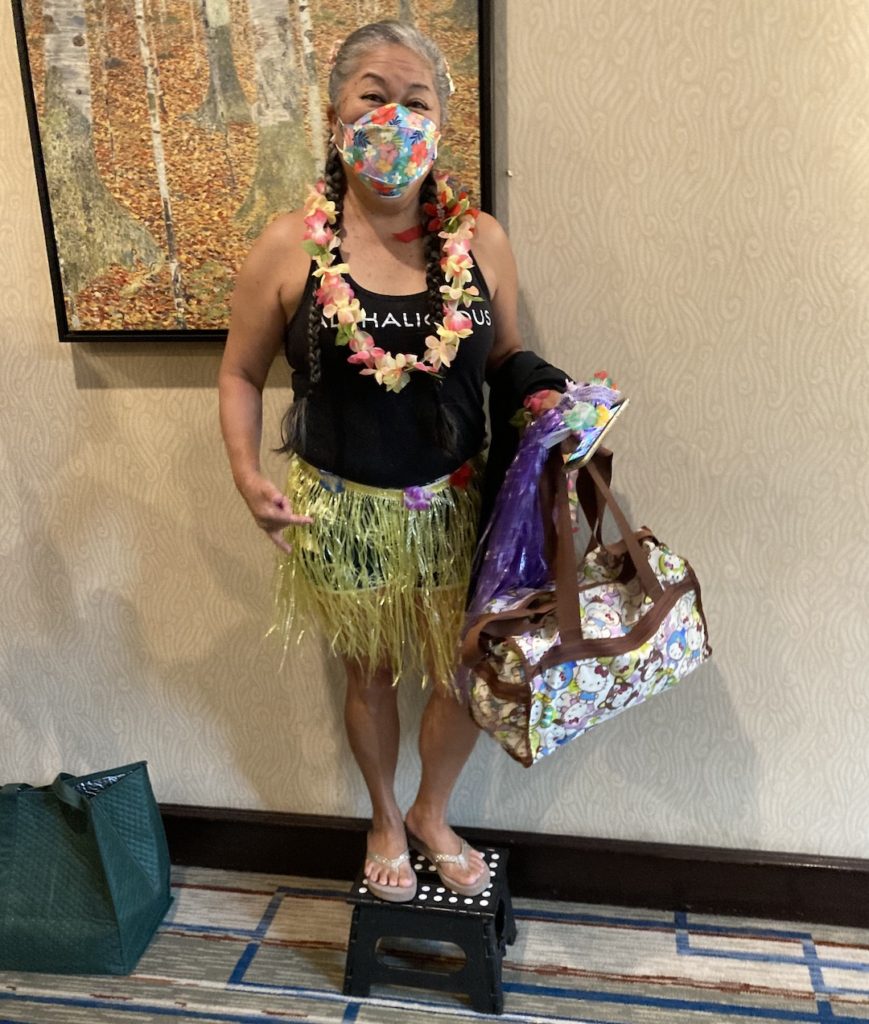
Jody told Cesar and Lauren that she did not like either Fergus or Marsali in the books. Fergus was a “sexist pig” and Marsali was mean and only had kid after kid and why didn’t she listen to Claire about birth control? LL: Lauren said she worked to have us love Marsali, and indeed she did/does a fabulous job. We LOVE her portrayal of Marsali. CD: Buckle up in S6. Cesar said good things are coming up for Fergus in S6! Cannot wait! CD: He loves how Americans pronounce his name: See-zer or Say-Zar. He pronounces it Sa-sar.
Q: What type of student were you? LL: Too chatty on report cards. She had a mean biology teacher. CD: Left school at 16 – a child actor. Cesar was told he needed to concentrate in school!
Next Panel – Saturday Afternoon: RR and SS
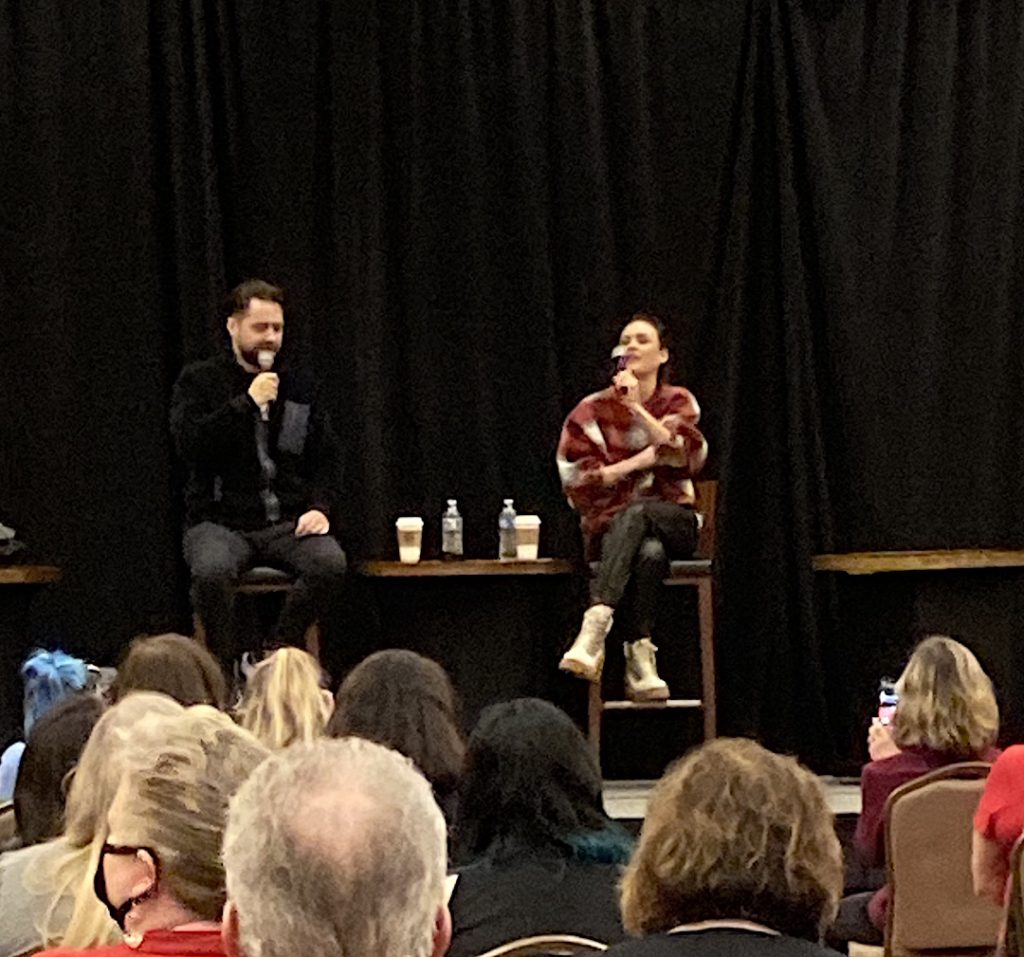
Q: Fav fun scene: SS: Anything with Jemmy (twins, Andrew and Matthew Adair, S5). She loves working with them. At the stone scene (Ep 511, Journeycake), he just wandered off! RR: Jemmy twins. Each time Jemmy reached for the tea kettle (Ep 508, Famous Last Words), Roger shouted, “no!” He said “kids were a nightmare” and told us when he yelled at the child actor (Andrew or Matthew), “NO!” using his scarred Roger throat, it terrified Andrew who recoiled saying “Don’t ever do that to me again!“
(These tears look pretty real!)
Quote from The Fiery Cross (Chapter 75):
I caught a glimpse of firelight shining on the bones of [Roger’s] face, and then his expression changed in an instant, from wariness to horror. He lunged to his feet, mouth open.
“STOKH!” he roared.
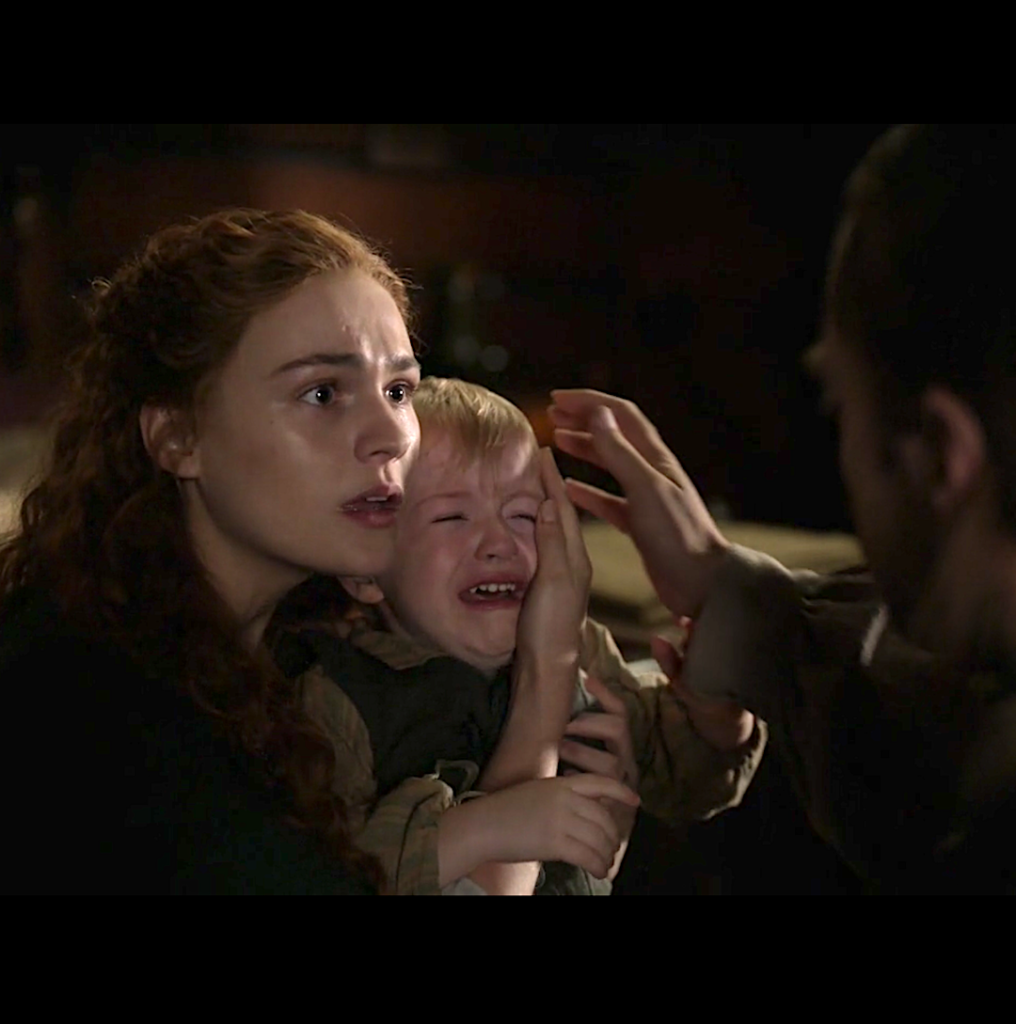
SS: Sophie said Richard is only interested in two things: his camera and video games. RR: As if on cue, Richard whipped out a couple of his prized cameras from a bag. A discussion ensued with some audience members about his cameras, lenses, etc. He brought five cameras on this trip. He carefully handed one for Sophie to hold while demonstrating and explaining the other camera; all mechanical. She did a fab job as Vanna! He watched her like a hawk and even let her take a picture of us with his camera! He said her photo was “good.” (damning with faint praise!) SS: Sophie quickly said, “Hold it like a baby” and “Support the head!”as Richard was lecturing her on how to hold the camera and to be careful. (Like a daddy with his kid, aye?)
Q: Fav Outlander scene: RR: “I will always sing for you” from ep 508 “Famous Last Words:”
This is the quote from “The Fiery Cross:”
Roger: “Everybody wants the old Roger back. I’ll never be that man again. I studied history. I taught it. Now I’m livin’ it. When I saw that tarot card, I thought, ‘this is who I am now. A dying man.’ Maybe this was my fate. My own ancestor tried to kill me. Maybe I wasn’t meant to exist.”
Brianna: “That isn’t true.”
Roger: “Perhaps not. But I have changed. Remember when you asked me about my last words?”
Brianna: “Yeah.”
Roger: “I thought I knew what they’d be, but what mattered was the last face I saw. That face was yours.”
Brianna: “Oh, Roger.”
Roger: “I’ll always sing for you. No matter what, no matter where. Whether you’re there to hear or even if my voice isn’t able, I will always sing for you.”
Q: To SS, how did you prepare for the rape scene? SS: Sophie watched a lot of You Tube and court cases of rape. She wanted to portray her response as tonic immobility. The victim cannot fight because her body shuts down in response to the trauma. It occurs in women who feel the trauma strongly.
Q: What other character would you like to play in the TV show? SS: Jamie RR: Bonnet, Jamie and Roger (News flash – Richard, you already play Roger!) SS: Rollo RR: At which point, Richard states he f**king hates Adso. We both hate cats. Cats are dicks! 🤷🏻♀️
Q: What role would you like to play in another film/show? RR: Sophie is a “Friends” fan. She would be Monica. SS: Richard would like to play Gunther.
Q: Most awkward scene? RR: Filming the last sex scene of S5, Roger lost his privacy pouch. SS: Similar to a “nip-slip.” The camera man got right in between them during the filming. Very intrusive! RR: Richard said to the crew, “Sorry you had to see that.”
Q: How did you prep for the birth scene (ep 413, Man of Worth)? SS: She watched many videos of births. Most shows have the woman screaming but she heard low, animalistic sounds during childbirth videos. She was very interested in the birthing chair. One crew member told her she was sitting in it wrong – she needed to squat on it and face the back. Sophie said “Thank you for mansplaining to me how to give birth!” Major applause from the audience!
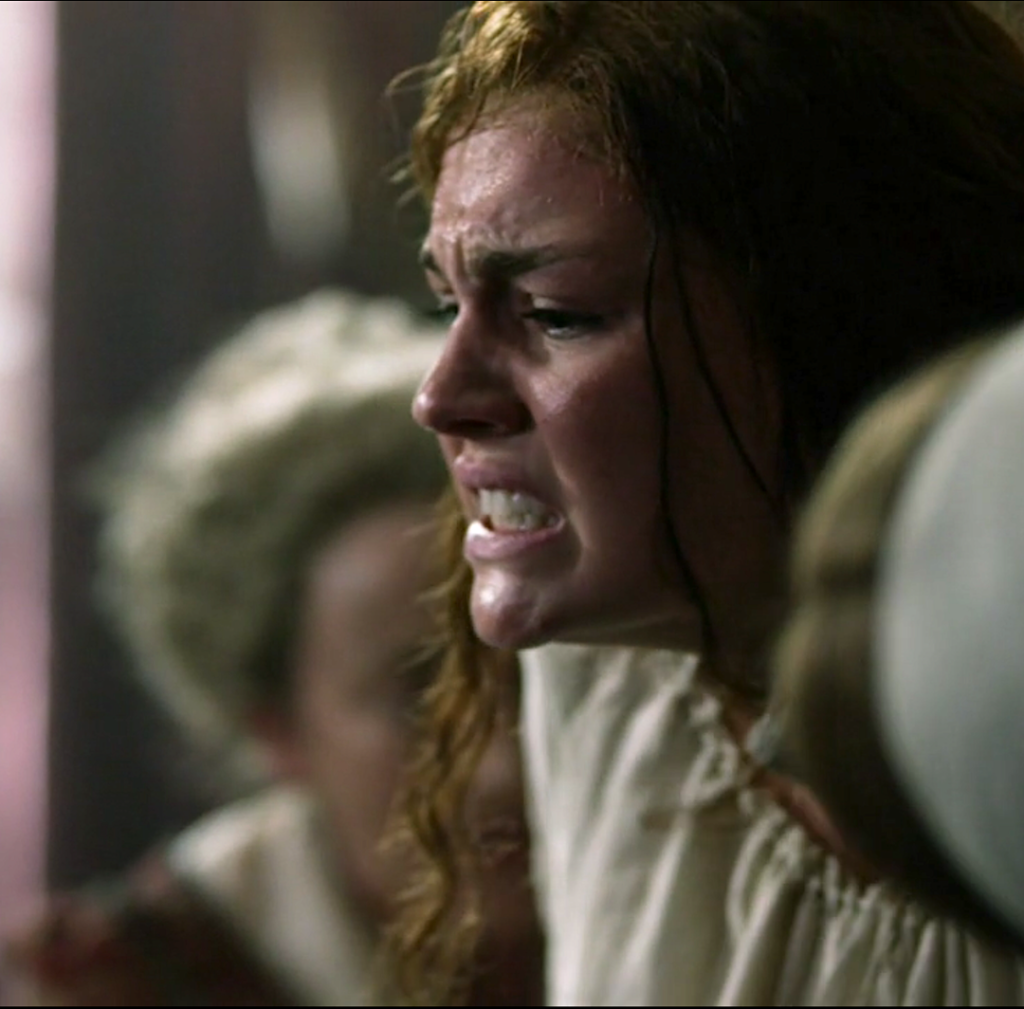
Q: We see your big beautiful dog on SM: RR: “I am right here!” 😁 SS: His name is Luca. He is 10 months old and 6’3” tall. Roger’s dog is Gonzo. During lockdown, Sophie took Luca and some friends to Richard’s house. She tried to get Luca to poop many times before the visit but no luck. Once inside, Luca pooped on Richard’s beautiful new multicolored, high-end carpet. The carpet has designs, but Luca went right on a white area! Her friend tried to clean it up but it just got worse. The cleanser contained bleach and soon it was apparent the carpet was Chlorox-ed. Sophie said: “Bye, we need to go!” Richard is silent. 🤐
Next Panel – Saturday Afternoon: RR, SC, DB, DL
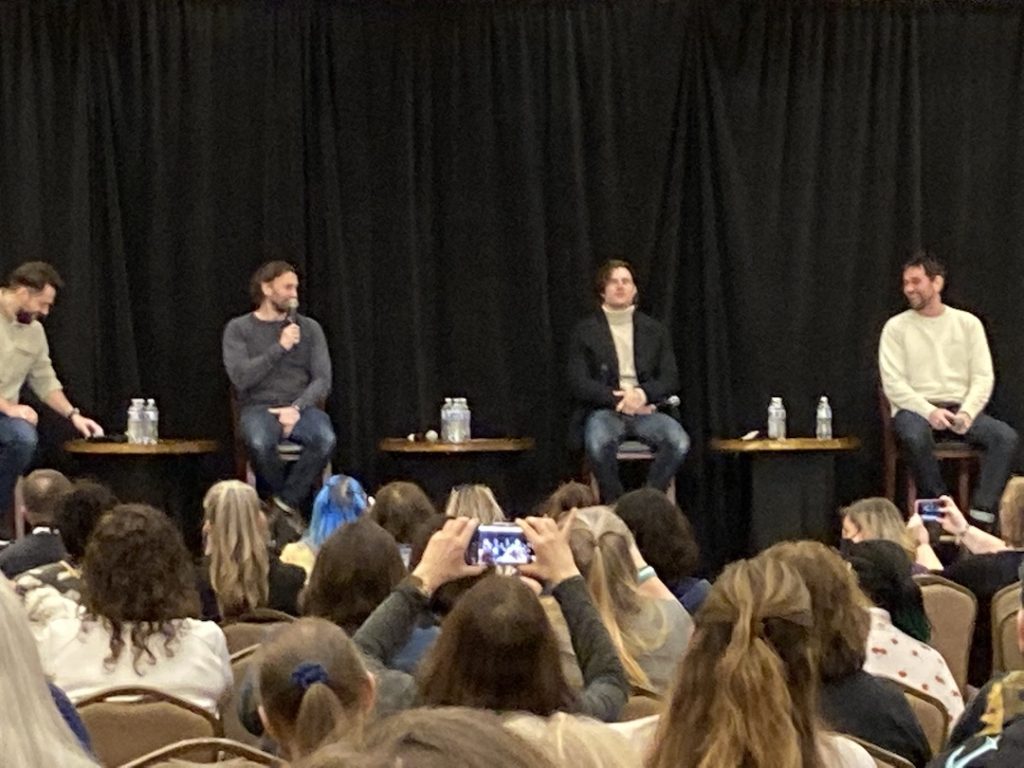
These lads were in fine fettle! First question?
Q: Meet our mascot known as “Murtagh’s dildo.” (It is an ear of corn in an “upright” posture) …Will we get to hear Roger sing the corn grinding song in S6?
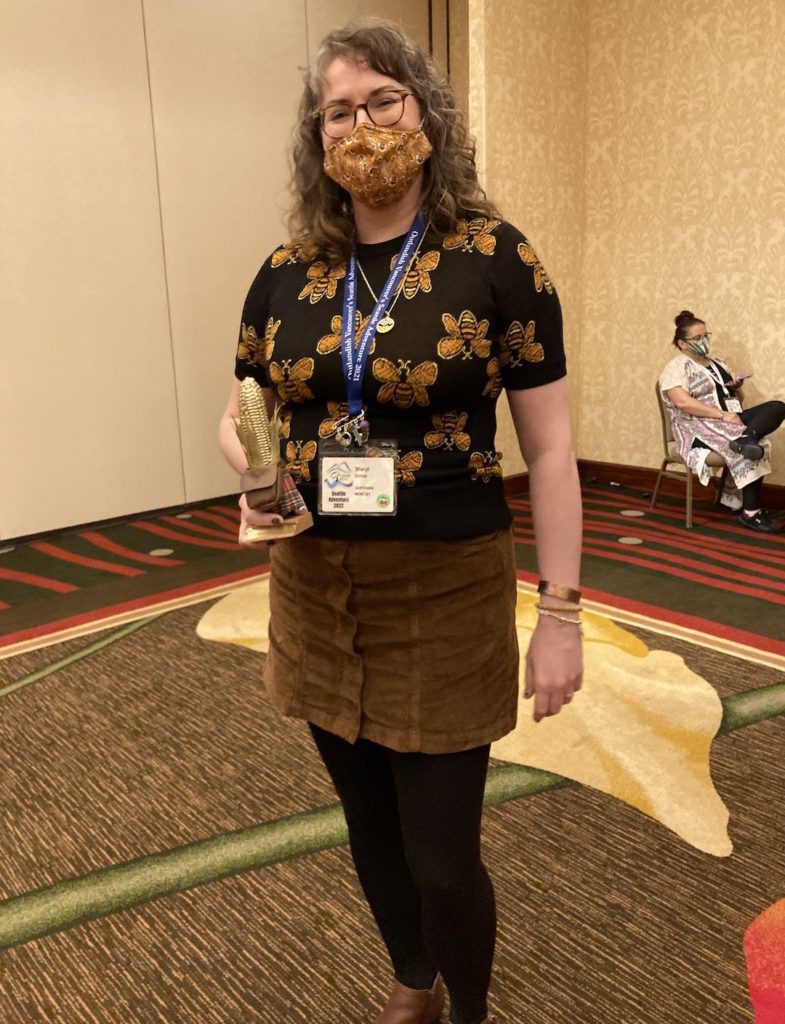
SC: WTF? 😂
Q: Which other Outlander character would you like to play? SC: BJR so he can do episodes 115 and 116 with Sam! DL: “Mark me!” Yep, he wants to play the Bonny Prince! DB: “Ian.” RR: DB would play a great Brianna! SC: People are complaining that Claire and Jamie aren’t shagging enough! (Steven was basically a stream of consciousness 😜)
Q: Not really a question but a comment praising SC for his work on men’s mental health. 👍🏻
Q: What nice thing happened on set? DL: “No one has ever said anything nice to me.” 🥺 DB: Carol Ann (Crawford), the dialect coach, helped David learn a lot of new lines quickly. She worked with him late into the night so he would be ready for filming. DL: I didn’t know she offered those services! SC: Carol Ann has no idea she is being implicated in a sex scandal right now! (David shakes his head – “Can’t say anything nice.”)
Q: How were you as a student? SC: Flew f-bombs all the time. When he was 10 y. o., a girl asked to get moved from his school table because he swore too much! DL: Went to a boy’s trade school that was rough. He faded into the background to survive. 😨 DB: Never got into trouble. Spent time doing music. SC: “Boo!” RR: At school, a four y. o. a girl asked him to stick his head under her skirt. He did and got into terrible trouble. Also, suspended for smashing a window. Always in trouble.
Q: Which actor would you like to work with: RR: Graham McTavish DL: John Sessions, who played Arthur Duncan, Geillis’ husband the pre-factor fiscal of Crainesmuir. SC: Tobiahs Menzes RR: Steven Cree, Tobiahs Menzes SC: “Everyone wants to play Jamie. He’s so wonderful. Blah, Blah: Eyes, arse, cock!” 😆
Q: How do you prepare for combat scenes? DL: Beheading the Duke of Sandringham (ep 312, The Hail Mary) took some preparation to get it right. Simon Callow was terrified. After the scene was over, Simon told the director, “Sam is a gentleman but that Duncan is a psychopath!” 🪓🩸
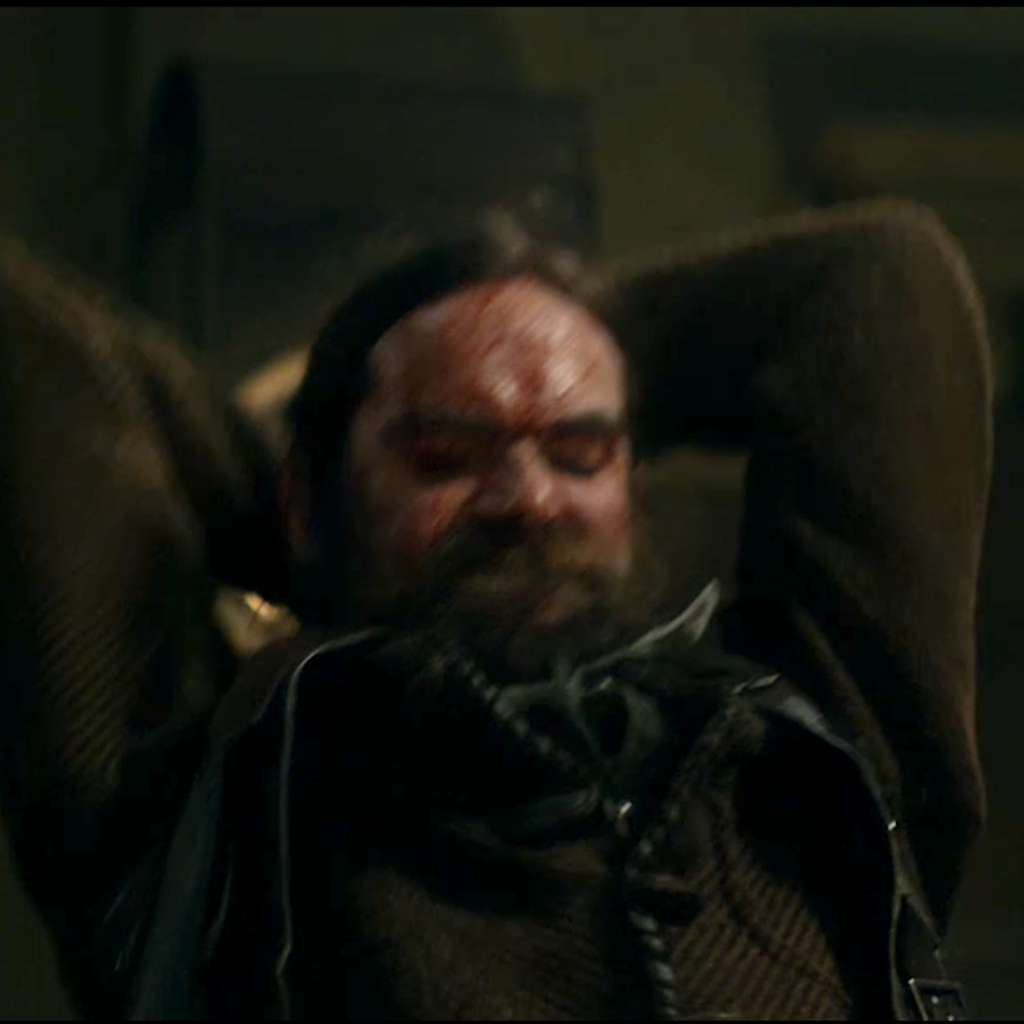
Q: How have things at Outlander evolved behind the scenes? DB: Feels bad he wasn’t in S1 because the fans are so nostalgic for it. SC: “F**king wonderful, a well-oiled machine!” RR: More efficient. Size and scale of all sets from S1 to present. All preserved and stored. Huge wardrobe department and armory.
Fan Comment: “David, thank you for portraying LJG with such sensitivity.” DB: It was tough to accept a part as a gay man because it was a big risk, but societal attitudes have changed. David tries to move the character in a slightly different direction so sexuality doesn’t define LJ – he tries to give LJ dimensions beyond his gayness to create a full human being.
Q: Did you have previous careers? DL: Plenty of jobs; hundreds of jobs in factories, cleaning roadways, etc. DB: A journalist. SC: Many jobs, worked in bars and restaurants and stuffed envelopes: he was a good letter licker! Wink, followed by a pregnant pause…. (Cheeky wee laddie) 😆 RR: Lots of jobs. Worked in Royal Bank of Scotland. Also sold kitchens and windows by cold-calling. If people were rude, he would say, “Oh, so you don’t want the round-the-world trip and hang up. Or, “ You don’t want your new BMW?” Richard was also a bar manager, and he quite liked that job.
Q: Favorite episode? DL: “Episode where Graham gets stabbed to death!” (ep 213, Dragonfly in Amber)
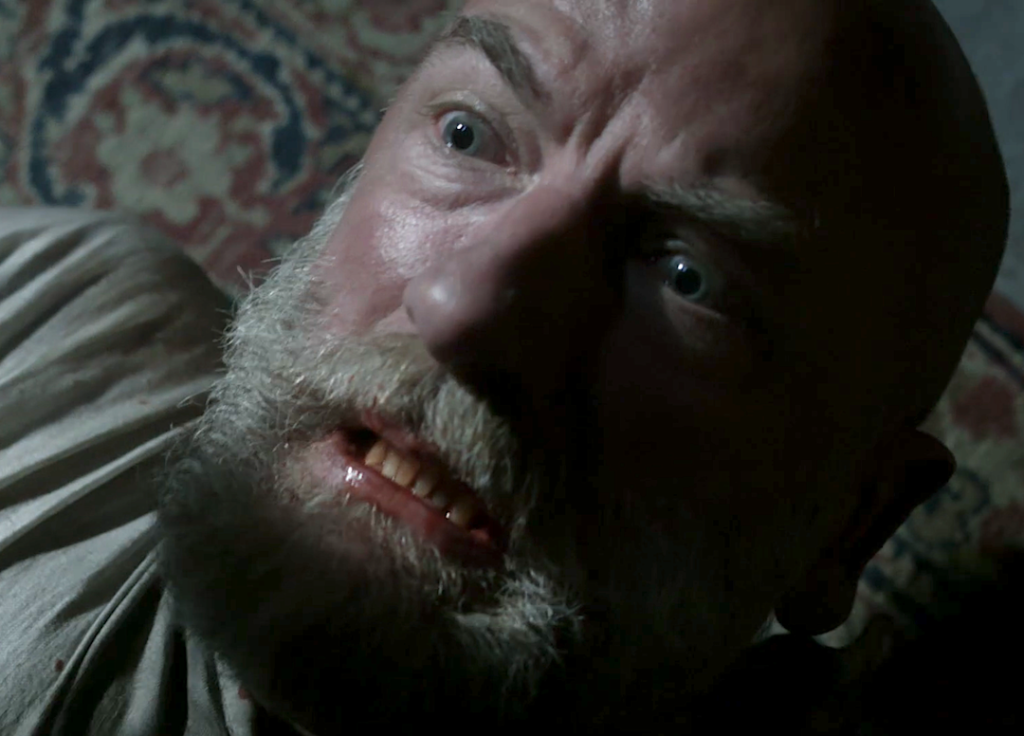 RR: The one where Roger goes back home to Inverness and settles down with a nice girl. DB: “The first episode I was in!” (ep 303, All Debts Paid) SC: “Episode one! Cunnilingus in the first 13 seconds!” They call it “downtown Frank!” 😱
RR: The one where Roger goes back home to Inverness and settles down with a nice girl. DB: “The first episode I was in!” (ep 303, All Debts Paid) SC: “Episode one! Cunnilingus in the first 13 seconds!” They call it “downtown Frank!” 😱
Next Panel – Saturday Afternoon: CD, SS, LL
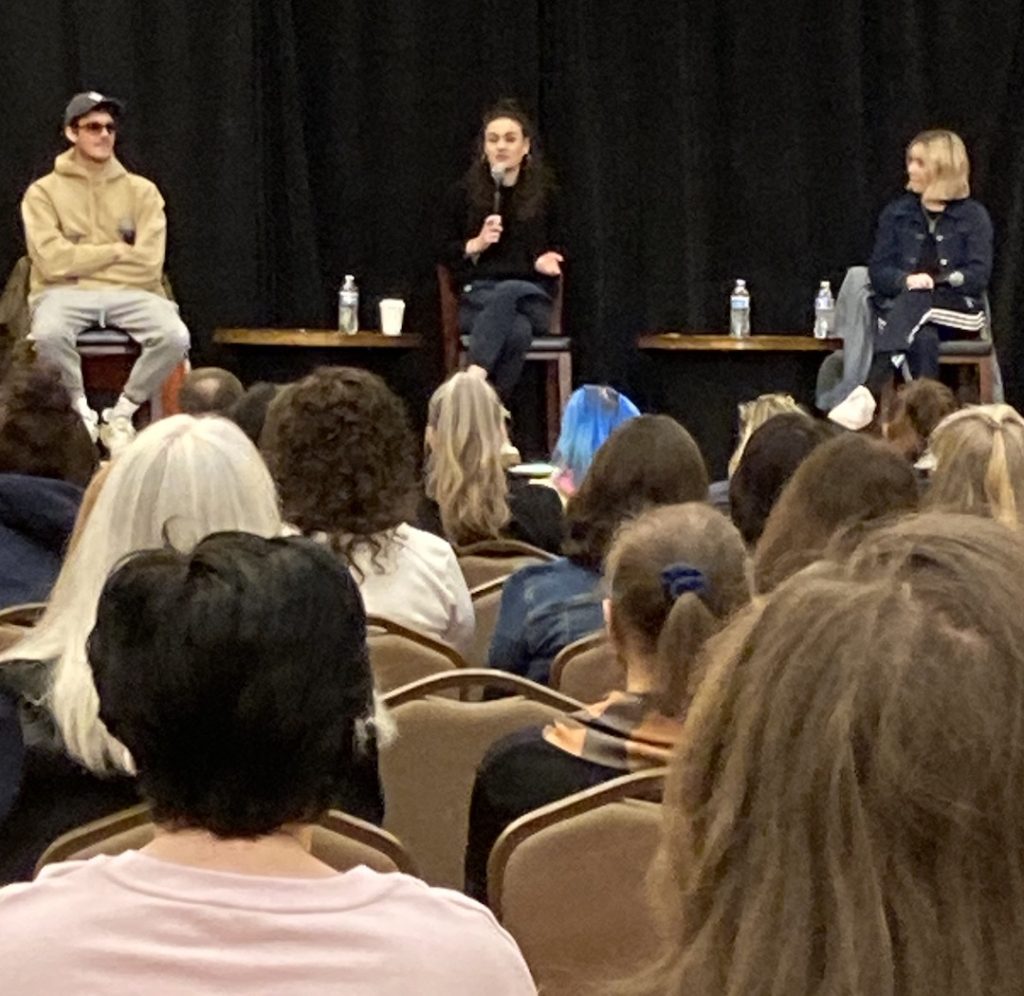
Q: Lauren, how did you prepare for the face plant (ep 511, Journeycake)? It looked so realistic! LL: At first a stunt woman was assigned to do the face plant, but Lauren decided she wanted to do it. The brick floor was replaced with a padded surface that only looked like a brick floor. She fell from a kneeling position. The first time hurt despite the padding. Then the stunt woman suggested Lauren let her shoulder take the impact, and that did the trick!
Yep, that was Lauren! 👍🏻
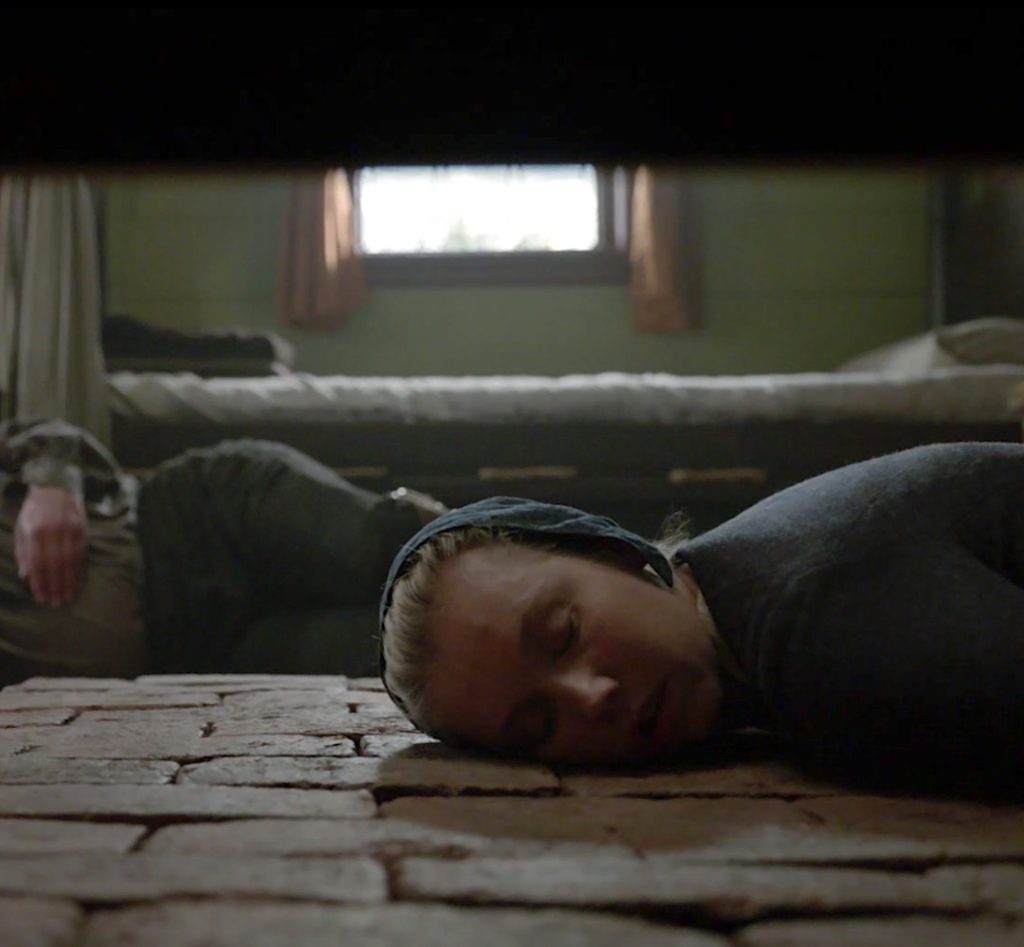
Q: Will we see Loughaire again? LL: Would love to work with Nell (Hudson) again. She only worked with her in one episode (ep 308, First Wife). No one knew if she will be back. Book readers know! Wink, wink. 🤞🏻
Q: Where will the S6 premier be held? Dead silence. No one would say. SS: Can you go to London? Wink, Wink, Wink!
Q: Do you like to do your own stunts? CD: He does his own stunts and uses his wooden hand as a weapon. He did a movie about free diving. He says it was terrifying just to stay alive. They were breathing through a straw and he suffered lots of panic attacks. Cesar learned to dive for the show, and he was scared! The untitled thriller will be shown on Netflix-France. LL and SS: Both want to Tom Cruise it.
Q: New projects other than Outlander? LL: Plays a detective in Karen Pririe, a series out this fall. She takes on a cold case of a murdered bar maid (ITV). CD: SAS Rogue Heroes where Peaky Blinders meets “something” (unintelligible) – on steroids! SS: A film with Diane Keaton is next – a ballet movie.
Q: Does your family watch your Outlander performances? SS: Yes, her family does watch, but not her friends. CD: His friends are disappointed in his choices. He asks Lauren to watch his performance and tell him how he did, “I’m too scared!” He doesn’t like to watch himself after doing his roles. SS: Richard does the same thing – “You just watch them for us.” LL: Friends don’t watch the show. Her 90 y. o. grandpa read the books but said “There are things I have to pass over.” (He has since passed) SS: Sophie was staying at her brother’s house and the neighbors showed films (including Outlander) outside on a huge garden wall. Her sister-in-law told Sophie to distract her brother not to look out the window – they were showing her sex scene with Richard.
Q: Favorite and least favorite set: LL: Hated Wilmington because it was wet and cold. Loved South Africa! CD: Loved their wedding scene (ep 311, Uncharted).
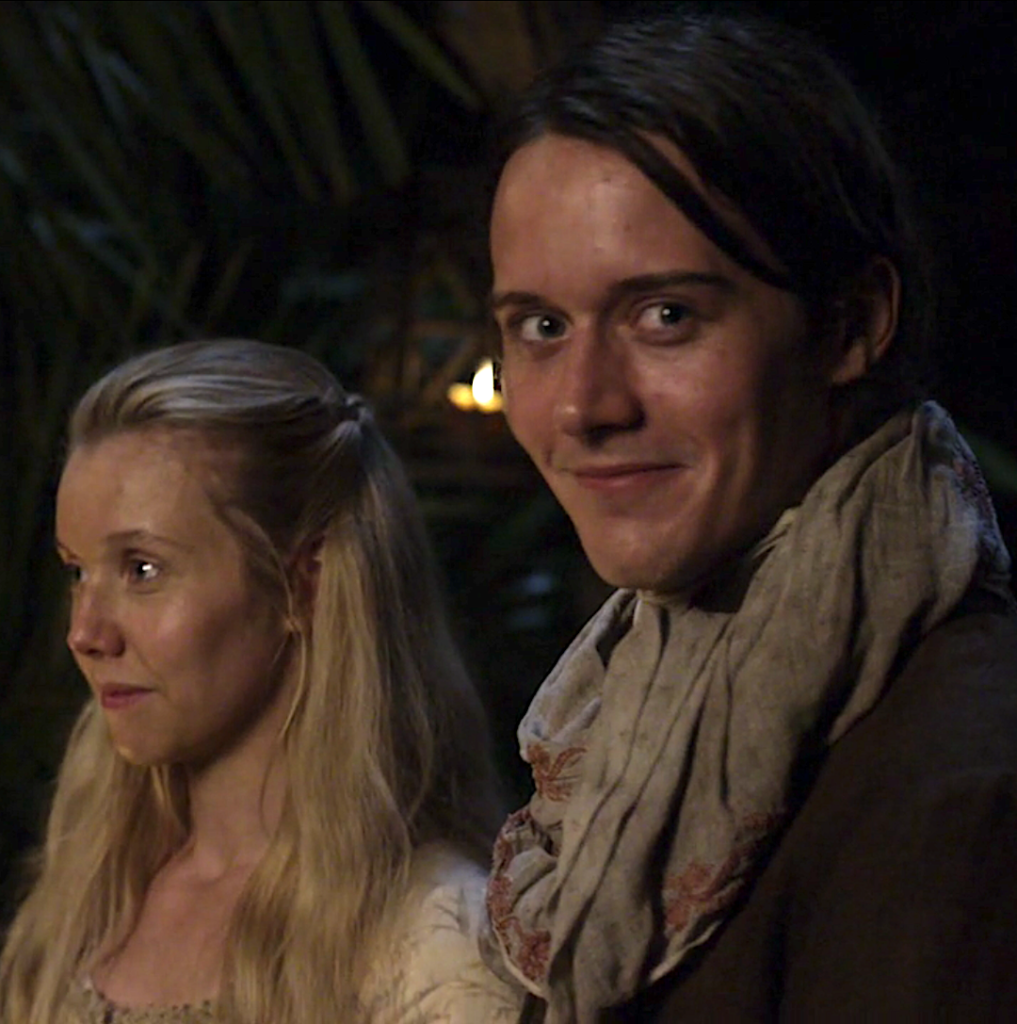
Cesar also shared that when he and Richard rode into Brownsville, the “mud movers” had made the road muddy. They were supposed to get off their horses as if heading to kick ass but were slipping all over the place. So instead of manly marching down the street, they had to take baby steps so as not to slip. In Cesar’s lilting French accent, “ It was so hard to be cool walking down the street because we were slipping in the mud.” He demonstrated that, and it was hilarious. Also, Richard fell getting off his horse!
Q: Have you taken anything from the set? LL: I have the wedding ring. She also wants a pot or crockery from their new cabin (!) in S6. CD: Hard to take anything. The crew is on it! SS: “I almost took the pearls!”
Q: How was it to work at night on episode 512, Never My Love? CD: It was like a dance. Very cold in the forest. And, you would never be in a forest at night. Super intense. High stakes.
Q: Do they send assessment emails after filming? SS: Yes, we get emails about what we can and cannot say. Publicists are clear about our talking points.
Closing Panel – Sunday: RR, SC, DL, SS, LL, CD, DB
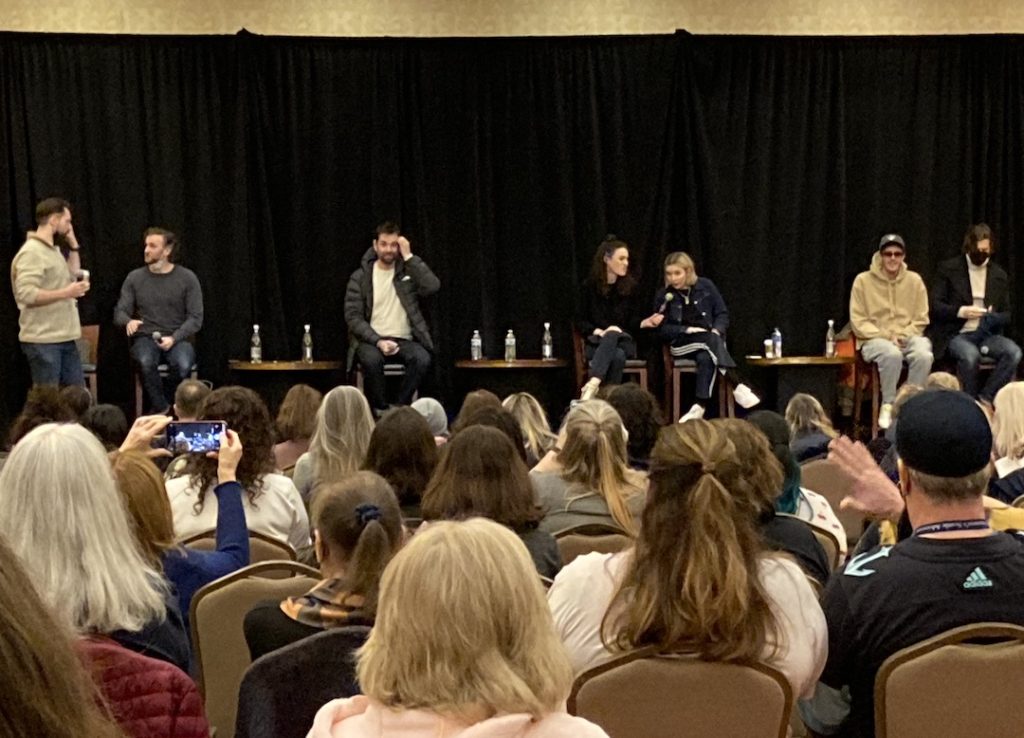
They all seemed pretty weary, which is why Steven might have quipped:
SC: Are you sick of us yet? Safe to say, “you can go fuck yourselves!” SS: “You guys rock.” RR: “What happens in Seattle……” DL: “Absolutely amazing. Duncan is going to have a long, very intimate adventure in the fog,” (very foggy out). SS: “Thanks to all of you!” RR: “Thanks!”
Q: How has your life changed during COVID? RR: More drinking home alone. Gonzo (his dog) drank with me. SC: Raised more money for “Cash for Kids” and “masturbating!” What??? LL: Long evening walks to clear my head. CD: Play Station, drinking alone, and more gym work. DB: Getting to know his 5 y. o. better. They threw a lot of tantrums together.
Q: What is your fav body of work? RR: Black Watch; Philomont SC: Cabaret in 2007, West End in London, and The Little Princess DL: “One man underneath the Lintel.” Seen by five people! (Duncan might have meant “Underneath the Lintel?”) LL: Karen Pririe! CD: His first film at 13 y. o. “My favorite show I’ve ever acted in was my first because my mom was so proud of me.” DB: His fav is the one yet to come. He loves the freshness.
Just two questions and then it was over! And, just like that, they bid us farewell! 👋🏻
An hour or so later, I hopped into my trusty Subaru, and headed for Oregon. It was a beautiful day and Mt. Hood looked spectacular!

Big hugs to my gal-pals who helped so much! 🤗
The deeply grateful,
Outlander Anatomist
Follow me on:
-
- Twitter: @OutLandAnatomy
- Facebook: OutlandishAnatomyLessons
- Instagram: @outlanderanatomy
- Tumblr: @outlanderanatomy
- Youtube: Outlander Anatomy
Photo Credits: Starz, Tom Cook, Jo KC, Ally Nisbet, Kristine Wilcox, Outlander Anatomy

